Application of Accounting Standards – CA Inter Advanced Accounts Question Bank is designed strictly as per the latest syllabus and exam pattern.
Application of Accounting Standards – CA Inter Advanced Accounting Question Bank
Question 1.
A company entered into an agreement to sell its immovable property to another company for 35 lakhs. The property was shown in the Balance Sheet at 7 lakhs. The agreement to sell was concluded on 15th February, 2008 and sale deed was registered 30th April, 2008. The financial statements for the year 2007-08 were approved by the board on 12th May, 08.
You are required to state, how this transaction would be dealt with in the financial statements for the year ended 31st March, 2008. (Nov 2009, 2 marks)
Answer:
Provision:
According to Para 13 of AS 4 “ContIngencies and Events Occurring after the Balance Sheet Date”, assets and liabilities should be adjusted for events occurring after the balance sheet date that provide additional evidence to assist the estimation of amounts relating to conditions existing at the balance sheet date or that indicate that the fundamental accounting
assumption of going concern ¡s not appropriate.
Analysis and Conclusion:
In the given question, sale of immovable property was carried out before the closure of the books of accounts. This ¡s clearly an event occurring after the balance sheet date but agreement to sell was effected on 15th February 2009 i.e. before the balance sheet date. Registration of the sale deed on 30th April 2009, simply provides additional information relating to the conditions existing at the balance sheet date. Hence, adjustment to assets for sale of immovable property is necessary in the financial statements for the year ended 31st March 2009.
Question 2.
A Company follows April to March as Its Financial Year. The Company recognizes cheques dated 31st March or before, received from customers after balance sheet date, but before approval of Financial statement by debiting cheques in hand A/c and crediting Debtors A/c. The cheques In hand is shown in the Balance Sheet as an item of cash and cash equivalents. All cheques in hand are presented to bank in the month of April and are also realised in the same month in normal course after deposit in the bank. State with reasons, whether the collection of cheques bearing date 31st March or before, but received after Balance Sheet date is an adjusting event and how this fact is to be disclosed by the company? (May 2010, 2 marks)
Answer:
Analysis and Conclusion:
Even if the cheques bear the date 31st March or before, the cheques received after 31 March do not represent any condition existing on the balance sheet date i.e. 31st March. Therefore, the collection of cheques after balance sheet date is not an adjusting event. ‘fleque that are received after the balance sheet date should be accounted for in the period in which they
are received even though the same may be dated 31st March or before as per AS 4 Contingencies and Events Occurring after the Balance Sheet Date”. Moreover, the collection of cheques after balance sheet date does not represent any material change affecting financial position of the enterprise, therefore, no disclosure in the Director’s Report is necessary.
Question 3.
While preparing its final accounts for the year ended 31st March 2010, a company made a provision for bad debts @ 4% of its total debtors (as per trend follows from the previous years). In the first week of March 2010, a debtor- for ₹ 3,00,000 had suffered heavy loss due to an earthquake; the loss was not covered by any insurance policy. In April 2010 the debtor becomes bankrupt. Can the company provide for the full loss arising out of insolvency of the debtor in the final accounts for the year ended 31st March 2010. (Nov 2010, 5 marks)
Answer:
Provision:
According to AS 4 Contingencies and Events Occurring After the Balance Sheet Date’, adjustments to assets and liabilities are required for events occurring after the balance sheet date that provide additional information materially affecting the determination of the amounts relating to conditions existing at the Balance Sheet date.
Analysis and Conclusion:
A debtor for ₹ 3,00,000 suffered heavy loss due to earth quake in the first week of March, 2010 and he became bankrupt in April 2010 (after the balance sheet date). The loss was also rot covered by any insurance policy. Accordingly. full provision for had debts amounting ₹ 3,00,000 should be made, to cover the less arising due to the insolvency of a debtor, in the final
accounts for the year ended 31st Mach, 2010.
![]()
Question 4.
MEC Limited could not recover an amount of 8 lakhs from a debtor. The company is aware that the debtor is in great financial difficulty. The accounts of the company for the year ended 31.3.2011 were finalized by making a provision @ 25% of the amount due from that debtor. In May 2011, the debtor became bankrupt and nothing is recoverable from him. Do you advise the company to provide for the entire loss of 8 lakhs in books of account for the year ended 31.3.2011? (Nov 2011, 4 marks )
Answer:
Provision:
As per AS 4, Contingencies and Events Occurring after the Balance Sheet Date, adjustments to assets and liabilities are required for events occurring after the balance sheet date in such event provides/relates to additional information to the conditions existing at the balance sheet date and is also materially affecting the valuation of assets and liabilities on the
balance sheet date.
Analysis and Conclusion:
As per the information given in the question, the debtor was already in a great financial difficulty at the time of closing of accounts, Bankruptcy of the debtor in May 2011 is only an additional information to the condition existing on the balance sheet date. Also the effect of a debtor becoming bankrupt is material as total amount of 8 lakhs will be a loss to me company. Therefore, the company is advised to provide for the entire amount of ₹ 8 lakhs in the books of account for the year ended 31st March, 2011.
Question 5.
Cashier of A-One Limited embezzled cash amounting to ₹ 6,00,000 during March, 2012. However same comes to the notice of company management during April. 2012 only. Financial statements of the company is not vet approved by the Board of Directors of the company. With the help of; provisions of AS 4 Contingencies and Events Occurring attr the Balance Sheet Date” decide. whether the embezzlement of cash should be adjusted in the books nf accounts for the year cradling March. 2012? What will be your reply if embezzlement of cash comes to the notice of company management only after approval of financial statements by the Board of Directors of she company? (May 2012, 4 marks)
Answer:
Provision:
According to AS 4, assets and liabilities should be adjusted for events occurring after the balance sheet date that provide additional evidence to assist the estimation of amounts relating to conditions existing at the balance sheet date.
Analysis and Conclusion:
1. Though the theft, by the cashier ₹ 6,00,000 was detected after the balance shoot off (before approval of financial statements) e.it is as an additional information materially affecting the determination of the cash amount relating to conditions existing at the balance sheet date.
2. Therefore it is necessary to make the necessary adjustments in the financial statements of the company for the year ended 31st March. 2012 for recognition of the loss amounting ₹ 6,00,000.
3. When embezzlement of cash comes to the notice of company management arty after approval of financial statements by Board of Directors of the company, then the treatment will be done as per the provisions of AS 5. This being extraordinary item should be disclosed in the statement of profit and loss as a part of loss for the year ending March 2013. The nature and the amount of prior period items should be separately disclosed on the statement of profit and loss in a manner that its impact on current profit or loss can be perceived.
Question 6.
Neel Limited has its corporate office in Mumbai and sells its products tc stock Lists all over India. On 31st March, 2013. the company wants to recognize receipt of cheques bearing date 31st March 2013 or before, as ”Cheques in Hand” by reducing trade Receivables”. The “Cheques in Hand” is shown in the Balance Sheet as an item of cash and cash equivalents. All cheques are presented to the bank in the month of April 2013 and are also realized in the same month in normal course after deposit in the bank. State with reasons, whether each of the following is an adjusting event and how this fact Is to be disclosed by the company, with reference In the relevant accounting standard.
(i) Chequis connected by the marketing personnel of the company from the stockists on or before 31st March, 2013.
(ii) Cheques sent by the stockists through courier on or before 31st March, 2013. (May 2013, 4 marks)
Answer:
(i) Cheques collected by the marketing personnel of the company is an adjusting event as the marketing personnel are employees of the company and therefore, are representatives of the company. Handing over of cheques by the stockist to the marketing employees discharges the liability of the stockist. Thus, cheques collected by the marketing personnel of the company on or before 31st March, 2013 require adjustment from the stockists’ accounts i.e. from ‘Trade Receivables A/c’ even though these cheques (dated on or before 31st March, 2013) are presented in the bank in the month of April, 2013 in the normal course.
Therefore, collection of cheques by the marketing personnel is an adjusting event as per AS 4 ‘Contingencies and Events Occurring after the Balance Sheet Date’. Such ‘cheques in hand’ will be shown in the Balance Sheet as ‘Cash and Cash equivalents’ with a disclosure in the Notes to accounts about the accounting policy followed by the company for such cheques.
Question 7.
State with reasons, how the following events would be dealt with in the financial statements of Pradeep Ltd. for the year ended 31st March, 2013:
(i) An agreement to sell a land for 30 lakhs to another company was entered into on 1st March, 2013. The value of land is shown at ₹ 20 lakh in the Balance Sheet as on 31st March, 2012. However, the Sale Deed was registered on 15th April, 2013.
(ii) The negotiation with another company for acquisition of its business was started on 2nd February, 2013. Pradeep Ltd. invested ₹ 40 lakh on 12m April, 2013. (Nov 2013, 5 marks)
Answer:
(i) Provision:
As per AS – 4 “ContingencIes and Events Occurring after the Balance Sheet Date”, assets and liabilities should be adjusted for events occurring after the balance sheet date that provide additional evidence to assist the estimation of amounts relating to conditions existing at the balance sheet date.
Analysis and Conclusion:
In the given situation, sale of land was carried out before the closure of the books of accounts. This is clearly an event occurring after the balance sheet date but agreement to sell was effected on 1st March 2013 i.e. before the balance sheet date. Registration of the sale deed on 15th April, 2013. simply provides additional Information relating to the conditions existing at the balance sheet date. Therefore, adjustment to assets for sale of land is necessary in the financial statements for the year 31st March 2013.
(ii) Provision:
According to AS – 4 “Contingencies and Events Occurring after the Balance Sheet Date”, which do not affect the figures stated in the financial statements would not normally require disclosure in the financial statements, although they may be of such significance that they may require a disclosure in the report of the approving authority to enable users of financial statements to make proper evaluations and decisions.
Analysis and Conclusion:
The investment of 40 lakhs in April 2013 for acquisition of another company is under negotiation stage, and has not been finalized yet. Also it is not affecting the figures stated inthe financial statements of 2012 -13, hence the details of the negotiation should be disclosed in the Directors Report to enable users of financial statements to make proper evaluations and decisions.
Question 8.
With reference to AS 4 Contingencies and events occurring after the balance sheet date, state whether the following events will be treated as contingencies adjusting events or non-adjusting events occurring after balance sheet in case of a company which follows April to March as its financial year.
(i) A major tire has damaged the assets in a factory on 5th April, 5 days after the year-end. However, the assets are fully insured and the books have not been approved by the Directors.
(ii) A suit against the company’s advertisement was tiled by a party on 10th April, 10 days after the year-end claiming damages of ₹ 20 lakhs.
(iii) It sends a proposal to purchase an immovable property for ₹ 30 lakhs in March. The book value in’ the property is ₹ 20 lakhs as on year-end date. However, the deed was registered as on 15th April.
(iv) The terms and conditions for acquisition of business of another company have been decided by March end. But the financial resources were arranged ri April and amount invested was ₹ 40 lakhs.
(v) Theft of cash of ₹ 2 lakhs by the cashier on 31st March but was detected the next day after the financial statements have been approved by the Directors. (May 2016, 5 marks)
Answer:
(i) As per AS-4, the loss due to major fire Is an example of event occurring after balance sheet date. This event does not relate to conditions existed at the balance sheet date. It has not affected financial position as on the balance sheet date and there fore requires no specific adjustments in The financial Statements, However, paragraph 8.6 of AS-4 states that disclosure is generally made of events occurring after balance sheet date i.e. subsequent periods that represent unusual changes affecting the existence or substratum of the enterprise aller the balance sheet date.
In this given case, a major fire has damaged the assets in a factory on 5th April and assets are fully insured so that ¡t may be considered as an event affecting the substratum of the enterprise because asset is insured but the loss due to it may not be fully recovered from insurance company. So that it is considered as non-adjusting events occurring after balance sheet date and should be disclosed in the report of the approving authority.
(ii) As per AS-4, events occurring after balance sheet date are those significant events, both favourable and un favourable that occur between the balance sheet date and the date on which financial statements are approved by board of directors or any other approving authority.
In this case, a suit against company’s advertisement was filed by a party on 10th April, for amount of ₹ 20 Lakhs. Therefore, it does not fit into the definition of a contingency and hence is a non-adjusting event.
(iii) In the given case, proposal for deal of immovable property was sent before the closure of the books of accounts. This is a non-adjusting event as only the proposal was sent and no agreement was effected in the month of March i.e. before the balance sheet date.
(iv) As the term and conditions of acquisition of business of another company had been decided by the end of March, acquisition of business is an adjusting event occurring after the balance sheet date. Adjustment to assets and liabilities is required since the event affects the determination and the condition of the amounts stated in the financial statements for the financial year ended on 31st March.
(v) Since the financial statements have been approved before detection of theft by the cashier of ₹ 2,00,000, it becomes a non-adjusting event and no disclosure is required in the report of the Approving Authority.
![]()
Question 9.
M/s AB Ltd. is in the process of analyzing its account for the year ended 31st March, 2015. The company seeks your advice on the following:
(i) The company’s sale tax assessment for assessment year 2012-13 has been completed on 1 14th February, 2015 with a demand of ₹ 5.40 crore. The company paid the entire due under protest without prejudice to Its right of appeal. The company files its appeal before the appellate authority wherein the grounds of appeal cover tax on additions made in the assessment order for a sum of ₹ 3.70 crore.
(ii) The company has entered Into a wage agreement in May 2015 where by the labour union has accepted a revision ¡n wage from June 2014. The agreement provides that the hike till May 2015 will not be paid to the employees but will be settled to them at the time of retirement. The company agrees to deposit the arrears in Government Bonds by September 2015. (May 2016, 5 marks)
Answer:
(i) This given situation is considered as per provision of AS-4. Contingencies and events occurring after the balance sheet date. As per AS-4 events that occur between balance sheet date and date of approval of financial statement should be disclosed.
In this case, the company is not appealing against addition of ₹ 1.7 crore, the same should be provided for in its accounts for the year ended 31st March. 2015. The amount paid under protest can be kept under the subheading ‘Short-Term Loans and Advances’ and disclosed along with the contingent liability of ₹ 3.70 crore.
(ii) As per AS-4 Contingencies and events occurring after balance sheet date, the events should be disclosed which have effect In the current financial year and such events have occurred during the financial year. The principle of accrual is applied here. As per this principle the income and expenses are realised in books they are earned and incurred but not by receipt and payment. So that in this case wage agreement decided in May 2015 so that it is event occurring after balance sheet date. The arrears for period from June 2014 to March 2015 are required to be provided for in the accounts of the company for the year ended 31st March. 2015.
Question 10.
While preparing its final accounts for the year ended 31st March. 2016. a company made provision for bad debts @ 5% of its total debtors. In the last week of February, 2016 a debtor for ₹ 20 lakhs had suffered heavy loss due to an earthquake; the loss was not covered by any insurance policy. In April, 2016 the debtor became a bankrupt. Can the company provide for the full loss arising out of nsolvericy of the debtor in the final accounts for the year ended 31st March. 2016? Comment with reference to relevant Accounting Standard. (Nov 2016, 5 marks)
Answer:
Provision:
As per para 8 of AS 4 ‘Contingencies and Events Occurring after the Balance Sheet Date Adjustment to assets and liabilities are required for events occurring after the balance sheet date that provide additional information materially affecting the determination of the amounts relating to conditions existing at the balance sheet date.
Analysis & Conclusion:
A debtor for ₹ 20,00000 suffered heavy loss due to earthquake n the last week of February, 2016, which was not covered by insurance. This information was already known to the company. The fact that he become bankrupt in April, 2016 is only an additional information related to the existing condition on the Balance Sheet date. Accordingly, full provision for bad debts amounting ₹ 20,00,000 should be made, to cover the loss arising due to the insolvency of a debtor, in the Final A/c for the year ended 31st March, 2016.
Question 11.
The Board of Directors of M/s. New Graphics Ltd. in its Board Meeting held on 18th April, 2017, considered and approved the Audited Financial results along with Auditors Report for the Financial Year ended 31st March, 2017 and recommended a divided of 2 per equity share (on 2 crore fully paid up equity shares of ₹ 10 each) for the year ended 31st March, 2017 and if
approved by the members at the forthcoming Annual General Meeting of the company on 18th June, 2017, the same will be paid to all the eligible shareholders.
Discuss on the accounting treatment and presentation of the said proposed dividend in the annual accounts of the company for the year ended 31st March, 2017 as per the applicable Accounting Standard and Other Statutory Requirements. (May 2017, 5 marks)
Answer:
As per the amendment in AS 4 “Contingencies and Events Occurring After the Balance Sheet Date” vide Companies (Accounting Standards) Amendments Rules, 2016 the events which take place after the balance sheet date, are sometimes reflected in the financial statements because of statutory requirements or because of their special nature. However, dividends declared after the balance sheet date but before approval of financial statements are not recognized as a liability at the balance sheet date because no statutory obligation exists at that time. Hence. such dividends are disclosed ri the notes to financial statements.
Present Case:
Provision for proposed dividends Is riot required to be made. Such proposed dividends are to be disclosed In trie notes to financial statements. Accordingly, the dividend of ₹ 4 Crores recommended by New Graphics Ltd. In its Board meeting on 18th April. 2017 shall not be accounted for In the books for the year 2016-17 irrespective of the fact that it pertains to the year 2016-17 and will be paid after approval in the Annual General Meeting of the members/ shareholders.
Question 12.
The accounting year of Dee Limited ended on 31st March, 2018 but the accounts were approved on 30th April, 2018. On 15th April, 2018 a fire occurred in the factory and office premises. The loss by fire is of such a magnitude that it was not possible to expect the enterprise Dee Limited to start operation again. State with reasons, whether the loss due to fire is an adjusting or non-adjusting event and how the fact of loss is to be disclosed by the company in the context of the provisions of AS-4 (Revised). (Nov 2018, 5 marks)
Answer:
AS 4 (Revised) “ContingencIes and Events occurring after the Balance Sheet Date,” states that adjustments to assets and liabilities are not appropriate for events occurring after the balance sheet date if such events do not relate to conditions existing at the balance sheet date. However, an event occurring after the balance sheet date should be an adjusting event
even if It does not reflect any condition existing on the balance sheet date if the event is such as to indicate that the fundamental accounting assumption of going concern is no longer appropriate.
Present Case:
A fire occurred in the factory and office premises of an enterprise after 31/03/2018. But before approval of financial statement of 2017-18. The loss on fire is of such a magnitude that it is not reasonable to expect the company to start its operation again. i.e. the going concern assumption is not valid. Since the fire occurred after 31/03/2018, the loss on fire is not a result of any condition existing on 31/0312018. In such a case, the entire accounts need to be prepared on a liquidation basis with adequate disclosures.
Question 13.
State whether the following statement is ‘True’ or False’. Also, give reason for your answer.
As per the provisions of AS-4, a contingency is a condition or situation, the ultimate outcome of which (gain or loss) will be known all’ determined only on the occurrence of one or more uncertain future events. (May 2019, 1 mark)
Answer:
This statement is False As per AS 4, a contingency is a condition or situation the ultimate outcome of which, gain or loss, will be known or determined only on the occurrence, or non-occurrence of one or more uncertain future events.
Question 14.
The financial statements of PQ Ltd. for the year 2017-18 approved by the Board of Directors on 15th July, 2018. The following information was provided:
(i) A suit against the company’s advertisement was filed by a party on 20th April, 2018, claiming damages of ₹ 25 lakhs.
(ii) The terms and conditions for acquisition of business of another company have been decided by March 2018. But the financial resources were arranged in April, 2018 and amount invested was ₹ 50 lakhs.
(iii) Theft of cash of 5 lakhs by the cashier on 31st March, 2018 but was detected on 16th July, 2018.
(iv) Company sends a proposal to sell an immovable property for ₹ 40 lakhs in March, 2018. The book value of the property is ₹ 30 lakhs on 31st March, 2018. However, the deed was registered on 15th April, 2018.
(v) A major fire has damaged the assets in a factory on 5th April, 2018. However, the assets are fully insured.
With reference to AS-4 “Contingencies and events occurring after the balance sheet date”, state whether the above mentioned events will be treated as contingencies, adjusting events or non-adjusting events occurring after the balance sheet date. (May 2019, 5 marks)
Answer:
(i) Suit filed against the company is a contingent liability but it was not existing as on balance sheet date as the suit was filed on 20th April after the balance Sheet date. As per AS 4, ‘Contingencies’ used in the Standard is restricted to conditions or situations at the balance sheet date, the financial effect of which is to be determined by future events which may or may not occur. Hence, I will have no effect on financial statements and will be a non-adjusting event.
(ii) In the given case, terms and conditions for acquisition of business were finalised and carried out before the closure of the books of accounts but transaction for payment of financial resources was effected in April, 2018. This is dearly an event occurring after the balance sheet date. Hence, necessary adjustment 4o assets and liabilities for acquisition of business is necessary In the financial statements for the year ended 31st March 2018.
(iii) Only those significant events which occur between the balance sheet date and the date on which the financial statements are approved, may indicate the need for adjustment to assets and liabilities existing on the balance sheet date or may require disclosure. In the given case, theft of cash was detected on 16th July, 18 after approval of financial statements by the Board of Directors, hence no treatment is required.
(iv) Adjustments to assets and liabilities are not appropriate for events occurring after the balance sheet date, it such events do not relate to conditions existing at the balance sheet date. In the given case, sale of immovable property was under proposal stage (negotiations also not started) on the balance sheet date. Therefore, no adjustment to assets for sale of immovable property is required in the financial statements for the year ended 31st March, 2018.
(v) The condition of fire occurrence was not existing on the balance sheet date. Only the disclosure regarding event of fire and loss being completely insured may be given in the report of approving authority.
![]()
Question 15.
When can an item qualify to be a prior period item as per AS-5? (May 2008, 4 marks)
Answer:
Prior Period Item [Para 16 of AS-5 (Revised)]:
When incomes or expenses arise in the current period as a result of errors or omissions in the preparation of the financial statements of one or more prior periods, the said incomes or expenses must be classified as prior period items. The errors may occur as a result of mathematical mistakes, mistakes in applying accounting policies, misinterpretation of facts or
oversight.
The term does not include other adjustments necessitated by circumstances, which though related to prior periods, are determined In the current period e.g. arrears payable to workers in current period as a result of revision of wages with retrospective effect.
Question 16.
The company finds that the stock sheets of 31.3.2007 did not Include two pages containing details of inventory worth 20 lakhs. State, how will you deal with this matter In the accounts of A Ltd. for the year ended 31st March, 2008 with reference to AS 5. (Nov 2008, 2 marks)
Answer:
Provision:
As per AS -5, Prior Period Items are incomes or expenses which arise in current period as a result of error of omission in the preparation of financial statement of one or more prior periods.
Analysis and Conclusion:
In the above case, 2 pages of stock sheet were missing in financial statements of 2007. Due to this the closing stock of 2007 was shown short by ₹ 20 lakhs as a result of which the opening stock of 2008 was understated resulting into an over-valuation of profit in 2008. In the current year 2008, the prior period item will be adjusted by reducing the profit by ₹ 20 lakhs. Therefore, as per AS-5 a separate disclosure of prior period items should be shown separately in the statement of trading and Profit & Loss A/c in a manner that the impact on the current profit or loss can be perceived.
Question 17.
Explain the provisions of AS-5 regarding accounting treatment of prior period items. (May 2009, 4 marks)
Answer:
As per AS 5, Prior Periods Items are income or expenses, which arise, in the current period as a result of errors or omissions in the preparation of financial statements of one or more prior periods. The term does not Include Other adjustments necessitated by circumstances, which though related to prior periods, are determined in the current period. Example: arrears payable to workers in current period as a result of retrospective revision of wages.
The nature and amount of prior period items should be separately disclosed in the statement of profit and loss in a manner that their impact on current profit or loss can be perceived. As per para 19 of AS 5, prior period items are normally included in determination of net profit or loss for the current profit, they can be added (or deducted as the case may be) from the current profit. An alternative approach is to show such items in the statement of profit or loss after determination of current net profit or loss. In either case, the objective is to indicate the effect of such items on the current profit or loss.
Question 18.
Goods worth 5,00,000 were destroyed due to food in September 2006. A claim was logged with insurance company. But no entry was passed in the books for insurance claim in the financial year 2006-07, in March 2008, the claim was passed and the company received a payment of ₹ 3,50,000 against the claim. Explain the treatment of such receipt in final accounts for the year ended 31st March. 2008. (Nov 2009, 2 marks)
Answer:
According to the provisions, of AS 5 “Net Profit or Loss for the Period, Prior Period Items and Changes in Accounting Policies”, prior period items are incomes or expenses, which arise in the current period as a result of error or omissions in the preparation of financial statements of one or more prior periods. The nature and amount of prior period items should be separately disclosed in the statement of profit and loss.
Present case:
In the given question, it is clearly a case of error in preparation of financial statements for the financial year 2006-07. Therefore claim received in the financial year 2007-08 is a prior period item and should be separately disclosed In the statement of profit and loss for the year ended 31st March 2008.
Question 19.
A company created a provision of ₹ 75,000 for staff welfare while preparing the financial statements for the year 2007-08. On 31st March, in a meeting with staff welfare association, it was decided to increase the amount of provision for staff welfare to ₹ 1,00,000. The accounts were approved by Board of Directors on 15th April, 2008. Explain the treatment of such revision in financial statements for the year ended 31st March 2008. (Nov 2009, 2 marks)
Answer:
Provision:
According the provisions of AS-5, all items of income and expense which are recognised in a period are included in the determination of the net profit or loss for the period, This includes extraordinary items and the effects of changes in accounting estimates. However, the effect of such change in accounting estimate should be classified using the same classification In the statement of profit and loss, as was used previously, for the estimate.
Analysis and Conclusion:
According to AS 5 “Net Profit or Loss for the Period, Prior Period Items and Changes in Accounting Policies, the charge in amount of staff welfare provision amounting ₹ 25,000 is neither a prior period item nor an extraordinary item. li is a change in estimate, which has occurred in the year 2007-2008.
Question 20.
A Ltd. entered into a binding contract with C Ltd. to buy a machine for ₹ 1,00,000. The machine is to be delivered on 15th February, 2009. On 1st January, 09 A Ltd. changed its process of production. The new process will not require the machine ordered and it shall have to be scrapped after delivery. The expected scrap value of the machine is nil. Explain how A Ltd. should recognise the entire transaction in the books of account for the year ended 31st March 2009. (Nov 2009, 2 marks)
Answer:
A Ltd. entered into a binding contract with C Ltd. and therefoíe, it should recognise a liability of ₹ 1,00,000. The entire amount of purchase price of the machine should be recognised in the year ended 31st March 2009 as Loss because future economic benefit from the machine to the enterprise is improbable.

Question 21.
Closing stock for the year ending on 31.3.2010 is ₹ 50,000 which includes stock damaged in a lire in 2008-09. On 31.3.2009 the estimated net realisable value of the damaged stock was ₹ 12,000. The revised estimate of net reasable value included in dosing stock of 2009-10 is ₹ 4,000. Find the value of Closing stock to be shown in Profit and Loss account for the year 2009-10. (May 2010, 2 marks)
Answer:
The fall in estimated net realisable value of damaged stock ₹ 8,000 is the effect of change in accounting estimate. As per AS 5 ‘Net Profit or Loss for the Period, Prior Period Items and Changes in Accounting Policies’, the effect of a change in accounting estimate should be classified using the same class fication in the statement of profit and loss as was used previously for the estimate.
Therefore, the value of closing stock for the year 2009-10 with be as follows:

Question 22.
A company signed an agreement with the employee’s union on 01-09-2010 for revision of wages with retrospective effect from 01-04-2009. This would cost the company an additional liability of ₹ 10 lakhs per annum. Is a disclosure necessary for the amount paid in 2010-11. (May 2011, 4 marks)
Answer:
Provisions:
According to AS 5 (Revised), “Net Profit or Loss for the Period, Prior, period items and Changes in Accounting Policies, when items of income and expense within profit or loss from ordinary activities are of such size, nature or incidence that their disclosure is relevant to explain the performance of the enterprise for the period, the nature and amount of such items should be disclosed separately.
Analysis and Conclusion:
It is given that revision of wages took place on 1st September 2010 with retrospective effect from 1.4.2009. The arrear of wages payable for the period 01.4.2009 to 31.3.2010, cannot be taken as an error or omission in the preparation of financial statement and hence this expenditure cannot be taken as a prior period item. Additional wages liability of ₹ 20 lakhs should be Included in current years’ wages.
1. It may be mentioned that additional wages is an expense arising from the ordinary activities of the company. Although abnormal in amount, such an expense does not qualify as an extraordinary Item.
2. Thus, necessary disclosure should be made for the additional liability amounting ₹ 20 lakhs.
![]()
Question 23.
Tiger Motor Car Limited signed an agreement with its employees union for revision of wages on 01.07.2011. The revision of wages is with retrospective effect from 01.04.2008. The arrear wages up to 31.03.2011 amounts to ₹ 40,00,000 arid that (for the period from 01.04.2011 to 01.07.2011 amount to ₹ 3,50,000. In view of the provisions of AS 5 Net Profit or Loss for the period, Prior Period Items and Changes in Accounting Policies, decide whether a separate disclosure of arrear wages is required while preparing financial statements for the year ending 31.03.2012 (May 2012, 4 marks)
Answer:
Question shows that revision of wages took place in July. 2011 with retrospective effect from 1.4.2008. The arrear wages payable for the period (from 1.4.2008 to 31.3.2011 cannot be taken as an error or omission in the preparation of financial statements and hence this expenditure cannot be taken as a prior period item.
Additional wages liability of ₹ 40,00,000 (from 1.4.2008 to 31 .3.2011) should be included in current year’s wages. It may be considered that additional wages is an expense arising from the ordinary activities of the company. Although abnormal in amount, such an expense does not qualify as an extraordinary item. However, A 5, when items of income and expense within profit or loss from ordinary activities are of such size, nature, or incidence that their disclosure is relevant to explain the performance of the enterprise for the period, the nature and amount of such items should be disclosed separately.
However, wages payable for the current year (from 1.4.2011 to 1.7.2011) amounting ₹ 3,50,000 is not a prior period item hence need not be disclosed separately. This may be shown as current-year wages.
Question 24.
Closing Stock for the year ending on 31st March, 2013 is ₹ 1,50,000 which includes stock damaged in a fire in 2011-12. On 31st March 2012. the estimated net realizable value of the damaged stock was ₹ 12,000. The revised estimate of net realizable value of damaged stock included in closing stock at 2012-13 is ₹ 4000. Find the value of closing stock to be
shown in Profit and Loss Account for the year 2012-13, using provisions of Accounting Standard 5. (May 2013, 5 marks)
Answer:
Provision:
According to AS 5 Net Profit or Loss for the Period, Prior Period Items and Changes In Accounting Policies’, the effect of a change in accounting estimate should be classified using the same classification in the statement of profit and loss as was used previously for the estimate.
It is presumed that the loss by fire in the year ended 31.3.2012, i.e. difference of cost and NRV was shown in the profit and loss account as an extraordinary item. Reduction in estimated net realizable value of damaged stock ₹ 8,000 is the effect of change in accounting estimate.
Analysis and Conclusion:
Thus, in the year 2012-13, revision in accounting estimate should also be classified as extra-ordinary item in the profil and loss account, and closing stock should be shown excluding the value of damaged stock. Value of closing stock for the year 2012-13 will be as follows:

Question 25.
The Accountant of Mobile Limited has sought your opinion with relevant reasons, whether the following transactions will be treated as change in Accounting Policy or not for the year ended 31st March, 2017. Please advise him in the following situations in accordance with the provisions of relevant Accounting Standards:
(i) Provision for doubtful debts was created @ 2% till 31st March 2016. From the Financial year 201 6-2017, the rate of provision has been changed to 3%.
(ii) During the year ended 31st March, 2017, the management has introduced a formal gratuity scheme in place of ad-hoc ex-gratia payments to employees on retirement.
(iii) Till the previous year the furniture was depreciated on straight-line basis over a period of 5 years. From current year, the useful life of furniture has been changed to 3 years.
(iv) Management decided to pay pension to those employees who have retired after completing 5 years of service in the organization. Such employees will get pension of ₹ 20,000 per month. Earlier there was rio such scheme of pension in the organization.
(v) During the year ended 31st March 2017, there was change In cost formula in measuring the cost of inventories. (Nov 2017, 5 marks)
Answer:
AS-5 Changes in Accounting Policies
(i) Creating a provision for doubtful debts is an Accounting Estimate. An Accounting Estimate may have to be revised (a) if there are changes in circumstances on which the estimate was based, or (b) as a result of new information, more experience or subsequent developments. Hence, this is not a change in Accounting Policy.
(ii) Adaptation of an accounting policy for events or transactions that differ in substance from previously occurring events or transactions does not constitute a change in Accounting Policy.
(iii) As per AS 5 & AS 10 PPE, change ¡n the estimate of useful life of fixed assets should be considered as changes Accounting Estimates. Hence, this is not a change in Accounting Policy.
(iv) Adoption of a new Accounting Policy for events or transactions which did not occur previously or that were immaterial does not constitute a change in Accounting Policy.
(v) Change in cost formula in measuring the cost of inventories is a change in Accounting Policy.
Question 26.
M/s POR Ltd. is in the process of finalising its accounts for the year ended 31st March, 2018. The company seeks your advice on the following:
(i) Goods worth ₹ 5,00,000 were destroyed due to flood in September 2015. A claim was lodged with insurance company. But no, entry was passed in the books for insurance claims in the financial year 2015- 16. In March 2018, the claim was passed and the company received a payment of ₹ 3,50,000 against the claim. Explain the treatment of such receipt in final account for the year ended 31st March, 2018.
(ii) Company created a provision for bad and doubtful debts at 2.5% on debtor.., in preparing the financial statements for the year 2017-18.
Subsequently, on a review of the credit period allowed and financial capacity of the customers, the company decides to increase the provision to 8% on debtors as on 31. 03.2018. The accounts were not approved by the Board of Directors till the date of decision. While applying the relevant accounting standard, can this revision be considered as an extraordinary item or prior period item? (May 2018, 5 marks)
Answer:
(i) As per the provisions of AS -5, “Net Profit or Loss for the period, prior period items and changes, In Accounting policies”, prior period items are income or expenses, Which arise, in the current period as a result of error or omissions in the preparation of firtancial statements of one or more prior periods. Further, the nature and amount of prior period items should be separately disclosed in the statement of profit and loss in a manner that their impact on current profit or loss can be perceived.
In the given case, it is clearly a case of error in preparation of financial statements for The year 2015-16, Hence claim received in the financial year 2017-18 is a prior period item and should be separately disclosed in the statement of Profit and Loss.
(ii) As per para 21 of AS 5, “Net Profit or Loss for the period, prior period Items and changes in Accounting policies”, the preparation of financial statements involves making estimates which are based on the circumstances existing at the time when the financial statements are prepared. it may be necessary to revise an estimate in a subsequent period if there is a change in the circumstances on which the estimate was based. Revision of an estimate, by its nature, does not bring the adjustment within definitions of a prior period item or an extraordinary item para 21 of AS 5 (Revised) on Net Profit or Loss for the period, prior period Items, and changes in Accounting Policies).
In the given case, a limited company created 2.5% provision for doubtful debts for the year 2017-18. Subsequently, in 2018 the company revised the estimates based on the changed circumstances and wants to create 8% provision. As per AS -5 (Revised), this change in estimate is neither a prior period item nor an extraordinary item. However, as per para 27 of AS 5 (Revised), a change in accounting estimate which has material effect in the current period, should be disclosed and quantified. Any change in the accounting estimate which is expected to have a material effect in later periods should also be disclosed and quantified.
Question 27.
State whether the following statement is ‘True’ or False’. Also, give reason for your answer.
1. As per the provisions of AS-5, extraordinary items should not be disclosed in the statement of profit arid loss as a part of net profit or loss for the period. (May 2019, 1 mark)
Answer:
This statement is False.
As per AS 5 “Net profit or loss for the period, prior period items and change In accounting policies”. Extraordinary items should be disclosed in the statement of profit and loss as a part of net profit or loss for the period.
![]()
Question 28.
State whether the following items are an example of change in Accounting Policy/Change in Accounting Estimates/Extraordinary items/Prior period items/Ordinary Activity.
(i) Actual bad debts turning out to be more than provisions.
(ii) Change from Cost model to Revaluation model for measurement of carrying amount of PPE.
(iii) Government grant receivable as compensation for expenses incurred in previous accounting period.
(iv) Treating operating ease as finance lease.
(v) Capitalisation of borrowing cost on working capital.
(vi) Legislative changes having long-term retrospective application.
(vii) Change n the method of depreciation from straight line to WDV.
(viii) Government grant becoming refundable.
(ix) Applying 10% depreciation instead of 15% on furniture.
(x) Change in useful life of fixed assets. (Jan 2021, 5 marks)
Question 29.
Explain contract costs as per Accounting Standard -7 related to ‘Construction Contracts’. ( Nov 2009, 2 marks)
Answer:
According to AS 7 “Construction Contracts (revised 2002)”, contract cost should comprise:
- Costs that relate directly to the specific contract;
- Costs that are attributable to contract activity in general and can be allocated to the contract;
- Other costs as are specifically chargeable to the customer under the terms of the contract.
Question 30.
Answer the following:
An amount of ₹ 9,90,000 was incurred on a contract work up to 31-3-2010. Certificates have been received to date to the value of ₹ 12,00,000 against which 10,80,000 has been received in cash. The cost of work done but not certified amounted to ₹ 22,500. It is estimated that by spending an additional amount of ₹ 60,000 (including provision for contingencies) the work can be completed in all respects in another two months. The agreed contract price of work is ₹ 12,50,000. Compute a conservative estimate of the profit to be taken to the Profit and Loss Account as per AS-7. (Nov 2010, 4 marks)
Answer:
Computation of Estimated Profit as per AS 7
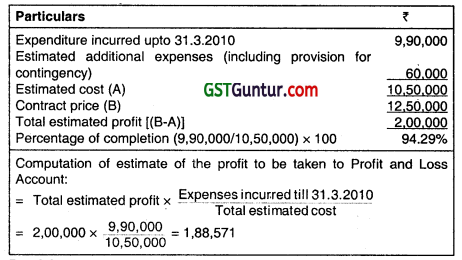
Provision:
According to AS-7, ‘Construction Contracts’, when the outcome of a construction contract can be estimated reliably, contract revenue and contract costs associated with the construction contract should be recognised as revenue arid expenses respectively by reference to stage of completion of the contract activity at the reporting date.
Analysis and Conclusion:
Therefore estimated profit amounting ₹ 1,88,571 should be recognised as revenue in the statement of profit and loss.
Question 31.
Answer the following:
From the following data, show. Profit and Loss A/c (Extract) as would appear in the books of a contractor following Accounting Standard -7:
| (₹ in lakhs) | |
| Contract Price (fixed) | 480.00 |
| Cost incurred to date | 300.00 |
| Estimated cost to complete | 200.00 |
(Nov 2011, 4 marks)
Answer:
Calculation of Estimated Total Cost

Percentage of completion (300/500) x 100 = 60%
Revenue recognized as a percentage to contract price
= 60% of ₹ 480 lakhs = ₹ 288 lakhs
As per para 35 of AS 7 ‘Construction Contracts, when it is probable that total contract costs will exceed total contract reveue, the expected loss should be recognized as an expense immediately. Accordingly, expenses to be recognized in the Profit and Loss Account will be
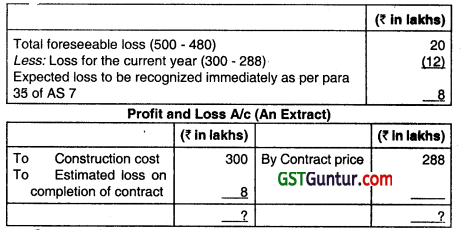
Question 32.
M/s Excellent Construction Company Limited undertook a contract to construct a building for ₹ 3 Crore on 1 ‘ September. 2011. On 31st March, 2012 the company found that it had already spent ₹ 1 Crore 80 Lakhs on the construction. Prudent estimate of additional cost for completion was ₹ 1 Crore 40 Lakhs. What amount should be charged, to revenue in the
final accounts for the year ended on 31 March 2012. as per the provisions of Accounting Standard 7 Construction Contracts (Revised)’? (May 2012, 5 marks)
Answer:
Computation of Estimated Cost of Construction:

Percentage of completion of contract till date to total estimated cost of construction = (1.80/3.20) x 100 = 56.25%
Proportion of total contract price considered as revenue as per AS 7 (Revised) = Contract price x percentage of completion
= 3 crores × 56.25% = 1.6875 crores
Question 33.
M/s. Highway Constructions undertook the construction of a highway on 01.04.2013. The contract was to be completed in 2 years. The contract price was estimated at ₹ 150 crores. Up to 31.03.2014, the company incurred ₹ 120 crores on the construction. The engineers involved in the project estimated that a further ₹ 45 crores would be incurred for completing the work. What amount should be charged to revenue for the year 2013-14 as per the provisions of Accounting Standard 7 Construction Contracts? Show the extract of the Profit & Loss A/c in the books of M/s. Highway Constructions. (May 2014, 5 marks)
Answer:
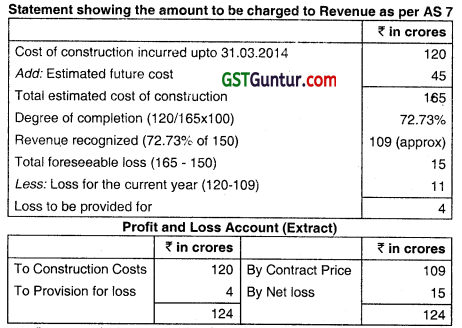
Question 34.
A construction contractor has a fixed price contract for ₹ 9,000 lacs to build a bridge in 3 years time frame. A summary of some of the financial data is as under:

‘Includes ₹ 100 lacs for standard materials stored at the site to be used in year 3 to complete the work. ‘Excludes ₹ 100 lacs for standard material brought forward from year 2. The variation in cost and revenue in year 2 has been approved by customer. Compute year-wise amount of revenue, expenses, contract cost to complete and profit or loss to be recognized in the Statement of Profit and Loss as per AS-7 (revised). (May 2015, 5 marks)
Answer:
The amounts of revenue, expenses and profit recognized in the statement of profit and loss in three years are shown below:

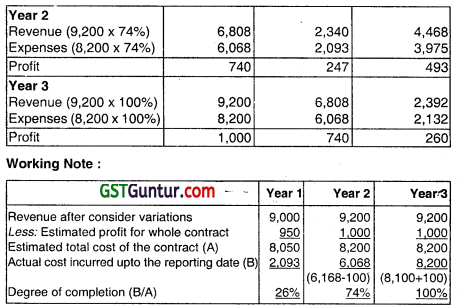
Question 35.
Uday Constructions undertake to construct a bridge for the Government of Uttar Pradesh. The construction commenced during the financial year ending 31.03.2016 and is likely to be completed by the next financial year. The contract is for a fixed price of ₹ 12 crores with an escalation clause. The costs to complete the whole contract are estimated at Z 9.50 crores
of rupees. You are given the following information for the year ended 31.03.2016:
Cost incurred upto 31.03.2016 ₹ 4 crores
Cost estimated to complete the contract ₹ 6 crores
Escalation in cost by 5% and accordingly the contract price is increased by 5%.
You are required to ascertain the state of completion and state the revenbe and profit to be recognized for the year as per AS-7. (May 2016, 5 marks)
Answer:

Stage of completion
Percentage of completion till date to total estimated cost of construction
= (4/10) x 100
= 40%
Revenue and Profit to be recognized for the year ended 31st March, 2016 as per AS-7
Proportion of total contract value recognized as revenue = Contract price × percentage of completion = ₹ 12.60 crore x 40% ₹ 5.04 crore
Profit for the year ended 31st March, 2016 = ₹ 5.04 crore less ₹ 4 crore = 1.04 crore.
![]()
Question 36.
GTI Ltd. negotiates with Bharat Oil Corporation Ltd. (BOCL), for construction of Retail Petrol and Diesel Outlet Stations. Based on proposals submitted to different Regional Offices of BOCL, the final approval for one outlet each in Region X, Region Y, Region Z is awarded to GTI Ltd. A single agreement is entered into between two. The agreement lays down values for each of the three outlets i.e. ₹ 102 Lakhs, ₹ 150 Lakhs,₹ 130 Lakhs for Region X, Region Y., Region Z respectively. Agreement also lays down completion time for each Region. Comment whether GTI Ltd. will treat it as single contract or three separate contracts with reference to AS-7? (Nov 2016, 5 marks)
Answer:
Provision:
As per AS-7 ‘Construction Contracts’ when a contract covers a number of assets, the construction of each asset should be treated as a separate contract when:
- separate proposals have been submitted for each asset;
- each asset has been subject to separate negotiation and the contractor and customer have been able to accept or reject that part of the contract relating to each asset; and
- the costs and revenues of each asset can be identified.
Analysis:
In the given case, GTI Ltd. negotiates with Bharat Oil Corporation Ltd. Separate proposal is submitted for each construction, though a single agreement is entered between the two. Also values for each contract is demanded separately such as ₹ 102 Lakhs,₹ 150 Lakhs, and ₹ 130 Lakhs for Region X, Region Y, and Region Z respectively.
Conclusion:
Thus, GTI Ltd. is required to treat construction of each unit as separate construction contract. Therefore, three separate contract accounts must be recorded and maintained in the books of GTI Ltd. For each contract principles of revenue and cost recognition must be applied separately and net income will be determined for each asset as per AS-7.
Question 37.
Akar Ltd. signed on 01/04116, a construction contract for 1.50,00.000. Following particulars are extracted in respect of contract, for the period ending 31/03/17.
Materials issued ₹ 75,00,000
Labour charges paid ₹ 36,00,000
Hire charges of plant ₹ 10,00,000
Other contract cost incurred ₹ 15,00,000
Out of material issued, material lying unused at the end of period is ₹ 4,00,000
Labour charges of ₹ 2,00,000 are still outstanding on 31.3.17. It is estimated that by spending further ₹ 33,50,000 the work can be completed in all respect.
You are required to compute profit-loss to be taken to Profit and Loss Account and additional provision for foreseeable loss as per AS-7. (May 2017, 5 marks)
Answer:
Computation of Amount to be charged to P & L and Additional Provision (As per AS-7)
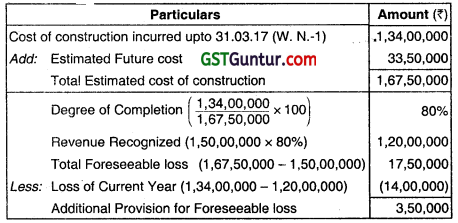
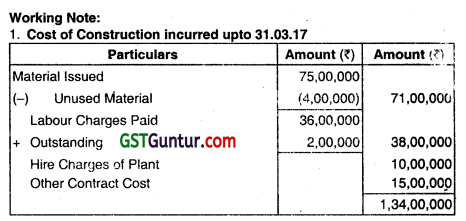
Question 38.
Santa Construction Co. obtained a contract for construction of a dam. The following details are available in records of company for the year ended 31st March 2018:
₹ in lakhs
Total Contract Price 12,000
Work Certified 6,250
Work not certified 1,250
Estimated further cost to completion 8.750
Progress payment received 5,500
Progress payment to be received 1,500
Applying the provisions of Accounting Standard 7 “Accounting for Construction Contracts” you are required to compute:
(i) Profit/Loss for the year ended 31st March 2018.
(ii) Contract work in progress as at end of financial year 2017-18.
(iii) Revenue to be recognized out of the total contract value.
(iv) Amount due from/to customers as at the year end. (May 2018, 5 marks)
Answer:
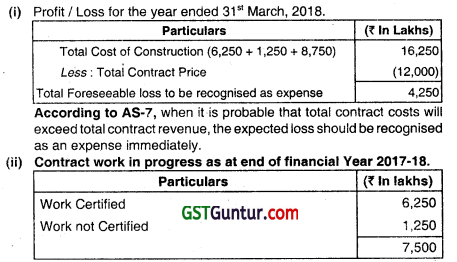
This is 46.15% (7,500/16,250 x 100) of total costs of construction.
(iii) Revenue to be recognised out of the total contract Value 46.15% of ₹ 12,000 Lakhs = ₹ 5,538 Lakhs.
(iv) Amount due from/to customers as at the year end Amount due from / to customers = (Contract Costs + Recognised Profits – Losses) – (Progress Payments Received + Progress Payments to be Received)
= (7,500 + Nil – 4,250) – (5.500 + 1,500) ₹ in Lakhs
= [3,250 – 7,000] ₹ in Lakhs
Amount due to customers = ₹ 3.750 lakhs
The amount of ₹ 3,750 Lakhs will be shown in the balance sheet as liability.
Question 39.
Answer the following questions:
(i) AP Ltd., a construction contractor, undertakes the construction of commercial complex for Kay Ltd. AP Ltd. submitted separate proposals for each of 3 units of commercial complex. A single agreement is entered into between the two parties. The agreement lays down the value of each of the 3 units, i.e. ₹ 50 Lakh. ₹ 60 Lakh and ₹ 75 Lakh respectively. Agreement also lays down the completion time for each unit. Comment, with reference to AS-7, whether AP Ltd., should treat it as a single contract or three separate contracts.
(ii) On 1st December 2017. GR Construction Co. Ltd. undertook a contract to construct a building for ₹ 45 lakhs. On 31st March, 2018. the company found that it had already spent ₹ 32.50 lakhs on the construction. Additional cost of completion Is estimated at ₹ 15.10 lakhs. What amount should be charged to revenue in the final accounts for the year ended 31 March 2018 as per provisions of AS-7? (May 2019, 5 marks)
Answer:
(i) As per AS 7 ‘ConstructIon Contracts’, when a contract covers a number of assets, the construction of each asset should be treated as a separate construction contract when:
(a) separate proposals have been submitted for each asset;
(b) each asset has been subject to separate negotiation and the contractor and customer have been able to accept or reject that part of the contract relating to each asset; and
(c) the costs and revenues of each asset can be identified. Therefore, AP. Ltd. is required to treat construction of each unit as a separate construction contract.

According to AS 7, the amount of ₹ 2.60 lakh is recognised as an expense.
Contract work ¡n progress = \(\frac{₹ 32.50 \text { lakhs } \times 100}{₹ 47.60 \text { lakhs }}\) = 68.28%
Proportion of total contract value recognised as turnover.
= 68.28% of ₹ 45 lakhs
= ₹ 30.726 lakhs
Question 40.
Answer the following:
Rajendra undertook a contract for ₹ 20,00,000 on an arrangement that 80% of the value of work done as certified by the architect of the contractee, should be paid immediately and that the remaining 20% be retained until the Contract was completed. In Year 1st the amounts expended were ₹ 8,60,000, the work was certified for ₹ 8,00,000, and 60% of this was paid as agreed. It was estimated that future expenditure to complete the Contract would be ₹ 10,00,000. In Year 2, the amounts expended were ₹ 4,75,000, Three-fourths of the Contract was certified as done by December 31st and 80% of this was received accordingly.
It was estimated that future expenditure to complete the Contract would be ₹ 4,00,000. In Year 3, the amounts expended were ₹ 3,10,000 and on June whole Contract was completed. Show how Contract revenue would be recognized in the P & L A/c of Mr. Rajendra each year. (Nov 2020, 5 marks)
Question 41.
X Undertook a Contract for ₹ 15,00,000 on an arrangement that 80% of the value of work done as certified by the architect of the Contractee, should be paid immediately and that the remaining 20% be retained until the Contract was completed.
In Year 1, the amounts expended were ₹ 3,60,000, the work was certified for ₹ 3,00,000 and 80% of this was paid as agreed. It was estimated that future expenditure to complete the Contract would be ₹ 10,00,000. In Year 2, the amounts expended were ₹ 4,75,000. Three-fourths of the Contract was certified as done by December 31st and 80% of this was received accordingly. It was estimated that future expenditure to complete the Contract would be ₹ 4,00,000. In Year 3, the amounts expended were ₹ 3,10,000 and on June 30th the whole Contract was completed. Show how Contract Revenue would be recognised in the P&L A/c each year.
Answer:

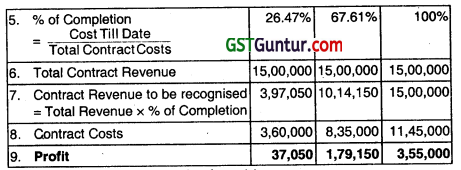
Question 42.
XYZ & Co. a Firm of Contractors, obtained a Contract for Construction of bridges across the river Revathi. The following details are available m the records kept for the year ending 31 March. (information ₹ Lakhs)
| Total Contract Price 1000 | Progress Payment Received 400 |
| Costs incurred till date 605 | Progress Payment to be Received 140 |
| Estimated further Cost to Completion 495 |
The Firm seeks your advice and assistance in the presentation of accounts keeping in view the requirements of AS – 7
Answer:
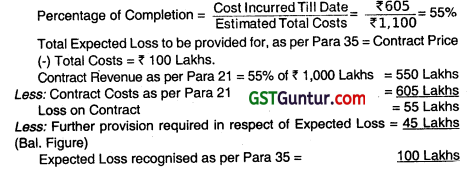
Amount due from /to customers = Contract Costs + Recognised Profits (-) Recognised Losses (-) Progress Billings
= 605 + Nil (-) 100 (-) 540 = (35) Lakhs
Amount Due to Customers.
This amount of ₹ 35 Lakhs will be shown in the Balance Sheet as a Liability.
Note: Progress Billings = Payments Received + Payments billed but not received.
Question 43.
XYZ Construction Co. Ltd. undertook a contract on 1st January to construct a building for ₹ 80 Lakhs. The Company found on 31st March that it had already spent ₹ 58,50,000 on the construction. Prudent estimate of additional cost for completion was ₹ 31,50,000.
What amount should be charged to Revenue and what amount of Contract Value to be recognized as Turnover in the accounts for the year ended 31st March as per provisions of AS-7?
Answer:
Estimated Total Contract Costs Cost till date + Further Costs = ₹ 58,50,000 + ₹ 31,50,000 = ₹ 90,00,000
Percentage of Completion = \(\frac{\text { Cost Incurred Tili Date }}{\text { Estimated Total Costs }}=\frac{₹ 58.50}{₹ 90.00}\) = 65%
Total Expected Loss to bo provided oi = Contract Price (-) Total Costs
₹ 80 (-) ₹ 90 = ₹ 10,00,000.
Contract Revenue as per Para 21 = 60% of ₹ 80 Lakhs = ₹ 52,00,000
(Contract Revenue to be recognized)
![]()
Question 44.
XYZ Ltd. undertook a Contract for building a Crane for ₹ 10 Lakhs. As on 31st March of a financial year, it incurred a cost of ₹ 1.50 Lakhs and expects that ₹ 9 Lakhs more will be required for completing the crane it has received so far ₹ 1.20 Lakhs as Progress Payment. Discuss the treatment of the above under AS-7.
Answer:
Percentage of Completion = \(\frac{\text { Cost Incurred Till Date }}{\text { Estimated Total Costs }}=\frac{₹ 1.50}{₹ 10.50}\) = 14.29%
Total Expected Loss to be provided for, as per Para 35= Contract Price (-) Total Costs = ₹ 0.50 Lakhs.
Contract Revenue as per Para 21 = 14.29% of ₹ 10 Lakhs = 1.43 Lakhs

Less: Further provision required in respect of Expected Loss = 0.43 Lakhs (Bal. Figure)
Expected Loss recognised as per Para 35 = 0.50 Lakhs
Amount due from / to customers = Contract Costs + Recognised Profits (-) Recognised Losses (-) Progress Billings
= 1.50 + Nil (-) 0.50 (-) 1.20 = (0.20)
Lakhs Amount Due to Customers.
This amount of ₹ 0.20 Lakhs will be shown in the Balance Sheet as a Liability.
Question 45.
Answer the following:
Y Ltd. used certain resources of X Ltd. In return, X Ltd. receives ₹ 10 lakhs and ₹ 15 lakhs as interest and royalties respectively, from Y Ltd. during the year 2007-08. State on what basis X Ltd. should recognize their revenue, as per AS 9. (Nov 2008, 2 marks)
Answer: –
According to AS-9 on Revenue Recognition, Interest of ₹ 10 lakhs received In the year 2007-08 should be recognized on the time proportion basis taking into account the amount outstanding and the rate applicable; whereas royalty of ₹ 15 lakhs received in the same year should be recognized on accrual basis as per the terms of relevant agreement.
Question 46.
According to Accounting Standard-9, when revenue from sales should be recognised? (May 2010, 2 marks)
Answer:
According to AS 9 ‘Revenue Recognition’, revenue from sales should be recognized only when requirements as to performance are satisfied provided that at the time of performance, it is not unreasonable to expect ultimate collection. These requirements can be given as follows:
(i) The seller of goods has transferred to the buyer the property in the goods for a price or all significant risks and rewards of ownership have been transferred to the buyer and the seller retains no effective control of the goods transferred to a degree usually associated with ownership; and
(ii) No significant uncertainty exists regarding the amount of the consideration that will be derived from the sale of the goods.
Question 47.
Answer the following:
M/s. SEA Ltd. recognized ₹ 5.00 lakhs on accrual basis Income from dividends during the year 2010-11. on shares of the lace value of ₹ 25.00 lakhs held by it in Rock Ltd. as at 3V March, 2011. Rock Ltd. proposed dividend @ 20% on 10m April, 2011. However, dividend was declared on 30th June, 2011. Please state with reference to relevant Accounting
Standard, whether the treatment accorded by SEA Ltd. is in order. (Nov 2011, 4 marks)
Answer:
Provision:
According to para 8.4 of AS-9 “Revenue Recognition, dividends from investments in shares are not recognized in the statement of Profit and Loss until the right to receive dividends is established.
Analysis and Conclusion:
In the given situation the dividend is proposed on 10th April, 2011. while it was declared on 30 June, 2011. Hence, the right to receive dividend is established on 30 June, 2011 only. Therefore, on applying the provisions stated In the standard, income from dividends on shares should be recognized by Sea Ltd. in the financial year 2011-2012 only. Therefore, the recognition of income from dividend of ₹ 5 lakhs. on accrual basis, in the financial year 2010-11 is not in accordance with AS-9.
Question 48.
Answer the following;
(d) M/s. Moon Ltd. sold goods worth ₹ 6,50,000 to Mr. Star. Mr. Star asked for a trade discount amounting to ₹ 53,000 and same was agreed to by M/s. Moon Ltd. The sales was effected and goods were dispatched. On receipt of goods. Mr. Star has found that goods worth ₹ 67,000 are defective. Mr. Star returned defective goods to M/s. Moon Ltd. and made payment due amounting to ₹ 5,30.000. The account art of M/s. Moon Ltd. booked the sale for ₹ 5.30,000. Discuss the contention of the accountant with reference to Accounting Standard (AS) 9. (May 2013, 4 marks)
Answer:
Provisions
As per AS-9, Revenue Recognition, revenue is the gross inflow of cash, receivable or other consideration arising in the course of the ordinary activities of an enterprise from the sale of goods. However, trade discounts and volume rebates given in the ordinary course of business should be deducted in determining revenue. Revenue from sales should be recognized at the time of transfer of significant risks and rewards. the delivery of the sales is not subject to approval from customers, then the transfer of significant risks and rewards would take place when the sale is affected and goods are dispatched.
Analysis and Conclusion:
In the given case, if trade discounts allowed by Mis. Moon Ltd. are given in the ordinary course of business, M/s. Moon Ltd. should record the sales at ₹ 5,97000 (i.e. ₹ 6,50,000 – ₹ 53,000) and goods returned worth ₹ 67,000 are to be recorded ¡n the form of sales return.
However, when trade discounts allowed by M/s. Moon Ltd. is not In the ordinary course of business, M/s. Moon Ltd. should record the sales at gross value of ₹ 6,50,000. Discount of ₹ 53,000 in price and return of goods worth ₹ 67,000 are to be adjusted by suitable provisions. M/s Moon Ltd. might have sent the credit note of ₹ 1,20,000 to Mr. Star to account for these adjustments. In both the cases, the contention of the accountant to book the sales for ₹ 5,30,000 is not correct.
Question 49.
A Ltd. entered into a contract with B Ltd. to desptch goods valuing ₹ 25,000 every month for 4 months upon receipt of entire payment. B Ltd. accordingly made the payment of ₹ 1,00,000 and A Ltd. started despatching the goods. In third month, due to a natural calamity. B Ltd. requested A Ltd. not to despatch goods until further notice though A Ltd. is holding the remaining goods worth ₹ 50,000 ready for despatch. A Ltd. accounted ₹ 50,000 as sales and transferred the balance to Advance Received against Sales. Comment upon the treatment of balance amount with reference to the provisions of Accounting Standard 9. (Nov 2013, 5 marks)
Answer:
Analysis:
According to AS-9, Revenue Recognition, in a transaction involving the sale of goods, performance should be regarded as being achieved when the following conditions are fulfilled:
(i) the seller of goods has transferred to the buyer the property in the goods for a price or all significant risks and rewards of ownership have been transferred to the buyer and the seller retains no effective control of the goods transferred to a degree usually associated with ownership; and
(ii) no significant uncertainty exists regarding the amount of the consideration that will be derived from the sale of the goods.
Conclusion:
In the given problem transfer of property in goods results in or coincides with the transfer of significant risks and rewards of ownership to the buyer. Also, the sale price has been recovered by the seller. Hence, the sale is complete but delivery has been postponed at buyer’s request. A Ltd. should recognize the entire sale of ₹ 1,00,000 (₹ 25,000 × 4) and no part of the same is to be treated as Advance Receipt against Sales.
Question 50.
Santa publishes a monthly magazine on the ir of every month. it sells advertising space in the magazine to advertisers on the terms of 80% sale value payable in advance and the balance within 30 days of the (elease of the publication, The sale of space for the March, 2014 issue was made in February 2014. The magazine was published on its scheduled date. It received ₹ 2,40,000 on 10.3.2014 and ₹ 60,000 on 10.4.2014 for the March 2014 issue. Discuss in the context of AS 9 the amount of revenue to be recognized and the treatment of the amount received from advertisers for the year” ending 31.3.2014. What will be the treatment f the publication is delayed till 2.4.2014? (Nov 2014, 5 marks)
Answer:
According to AS-9, ‘Revenue Recognition’, in a transaction involving the rendering of services, performance should be measured either under the completed service contract method or under the proportionate completion method as the service Is performed, whichever relates the revenue to the work accomplished.
In this case, income accrues when the related advertisement appears before public. The advertisement service would be considered as performed on the day the advertisement is seen by public and hence revenue is recognized on that date, so in this case, it is 15.03.2014, the date of publication of the magazine.
Therefore, ₹ 3,00,000 (₹ 2,40,000 + ₹ 60,000) is recognized as income in March 2014. The terms of payment are not relevant for considering the date on which revenue is to be recognized. ₹ 60,000 is treated as amount due from advertisers as on 31.032014 and ₹ 2,40,000 will be treated as payment received against the sale.
Whereas, if the publication is delayed till 02.04.2014 revenue recognition will also be delayed till the advertisements get published in the magazine. In such case revenue of ₹ 3,00,000 will be recognized for the year ended 31.3.2015 after the magazine is published on 02.04.2014. The amount received from sale of advertising space on 10.03.2014 of ₹ 2,40,000 will be considered as an advance from advertisers as on 31.03.2014.
Question 51.
Answer the following:
Given the following information of M/s. Paper Products Ltd.
(i) Goods of ₹ 60,000 were sold on 20-3-2015 but at the request of the buyer these were delivered on 10-4-2015.
(ii) On 15-1-20 15 goods of ₹ 150,000 were sent on consignment basis of which 20% of the goods unsold are lying with the consignee as on 31-3-2015.
(iii) ₹ 1,20,000 worth of goods were sold on approval basis on 1-12- 2014. The period of approval was 3 months after which they were considered sold. Buyer sent approval for 75% goods up to 31-1-2015 and no approval or disapproval received for the remaining goods till 31-3-2015.
(iv) Apart from the above, the company has made cash sales of ₹ 7,80,000 (gross). Trade discount of 5% was allowed on the cash sales.
You are required to advise the accountant of M/s. Paper Products Ltd., with vahd reasons, the amount to be recognized as revenue in above cases in the context of AS-9 arid also determine the total revenue to be recognized for the year ending 31-3-2015. (May 2015, 4 marks)
Answer:
(i) As per AS-9 “Revenue Recognition”, in a transaction involving the sale goods, performance should be regarded as being achieved when the following conditions are fulfilled:
(a) the seller of goods has transferred to the buyer the property in the goods for a price or an significant risks and rewards of ownership have been transferred to the buyer and the Soller retains no effective control of the goods transferred to a degree usually associated with ownership; and
(b) no significant uncertainty exists regarding the amount of the consideration that will be derived from the sale of the goods. In this transaction, the buyer sold goods of ₹ 60,000 on 20-3-2015 but at the request of the buyer these were delivered on 10-4-2015. As per AS-9, goods sold by company the right becomes to revenue recognised whether, the actual physical delivery of goods taken place or not. So here ₹ 60,000 of revenue is to be recognised as Sales in Trading A/c.
(ii) As per AS-9, if the goods are sent on consignment basis and if the agent sells them to third party then only the revenue is recognised by consignor. So here, goods of ₹ 1,50,000 sent on consignment and only 80% goods were sold. Thus, sales recorded will be only ₹ 1,20,000 In Trading A/c as per AS-9.
(iii) As per AS-9, revenue should be recognised on sale on approval basis as follows:
Revenue shall be recognised if the buyer formally accepted the goods. Revenue shall also be recognised lithe period of rejection has elapsed or where no time has been fixed or a reasonable time has elapsed. Here, total goods worth ₹ 1,20,000 are sold to customers on 1-12- 2014, on approval period of 3 months. Buyer sent approial for 75% goods up to 31-1-2015 and no approval or disapproval received for the remaining goods tIll 31-3-2015. As the approval time is elapsed on 31-3-2015, so all the goods sold on’ 1-12-2014 is to be considered as sales. So, ₹ 1,20,000 to be shown in Trading P&L A/c as sales as on 31- 3-2015.
(iv) Apart, from above the company has made cash sales of ₹ 7,80,000 (gross). Trade discount of 5% aHowed or, cash sales, so sale to be recorded as 7,80,000 – 39,000 = ‘ ₹ 7,41,000.
Calculation for total revenue to be recognised for the year endin9 31-3-2015

![]()
Question 52.
M/s Umang Ltd. sold goods through its agent. As per terms of sales, consideration is payable within one month. In the event of delay in payment, interest is chargeable @ 12% p.a. from the agent. The company has not realized interest from the agent in the past. For the year ended 31st March, 2015 interest due from agent (because of delay in payment) amounts to ₹ 1,72,000. The accountant of M/s Umang Ltd. booked ₹ 1,72,000 as interest income in the year ended 31st March, 2015. Discuss the contention of the accountant with reference to Accounting Standard-9. (Nov 2015, 5 marks)
Answer:
As per AS-9 “Revenue Recognition”, where the ability to assess the ultimate collection with reasonable certainty is lacking at the time of rising any claim, the revenue recognition is postponed to the extent of uncertainty. In such cases, the revenue is recognised only when it is reasonably certain that the ultimate collection will be made.
So in this case M/s Urnang Ltd. never realised interest for the delayed payments made by the agents. Hence. it has to recognize the interest onty If the ultimate collection is certain. The interest income of ₹ 1,72,000 is not be recognised in the year ended 31st March, 2015. So the contention of the accountant is wrong. It should not recognize it as interest income in the books of account for year ended 31st March, 2015.
Question 53.
A manufacturing company has the following stages of production and sak in manufacturing Fine paper rolls:
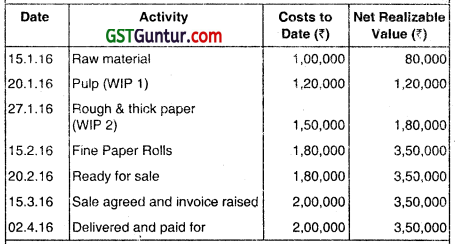
Explain the stage on which you think revenue will be generated and State how much would be net profit for year ending 31-3-16 on this product according to AS-9. (Nov 2016, 5 marks)
Answer:
Provision:
As per AS-9 ‘Revenue Recognition’ revenue in terms of sales could be recognised only when ownership has been passed by the seller to the buyer and there is no uncertainty regarding collection of consideration (sale proceeds) and it is reasonable to expect ultimate collection at the time of performance. Thus, sales will be recognized only when following two conditions are satisfied:
(i) The sate value is tixed and determinable.
(ii) Property 01 the goods is transferred to the customer.
Analysis:
In the given situation, company has sold goods and raised invoice on 15.3.16 and goods are ready for delivery. In that case company is entitled to recognise sale for the year ended 31.3.2016. provided delay in delivery is due to buyer’s request.
Calculation of NP Is as under:

Question 54.
Raj Ltd. entered into an agreement with Heena Ltd. to dispatch goods valuing ₹ 5,00,000 every month for next 6 months on receipt of entire payment. Heena Ltd. accordingly made the entire payment of ₹ 30,00,000 and Raj Ltd. started dispatching the goods. In fourth month, due to fire in premises of Heena Ltd.. Heena Ltd. requested to Raj Ltd. not to dispatch goods untill further notice. Due to this, Raj Ltd. is holding the remaining goods worth ₹ 15,00,000 ready for dispatch. Raj. Ltd. accounted ₹ 15.00,000 as sales and transferred the balance to Advance received against Sales account. Comment upon the above treatment by Raj Ltd. with reference to the provision of AS-9. (May 2017, 5 marks)
Answer:
As per AS-9 “Revenue Recognition”, in a transaction involving the sale of goods, performance should be regarded as being achieved when the following conditions are fulfilled:
1. The seller of goods has transferred to the buyer the property in the goods for price or all significant risks and rewards of ownership have been transferred to the buyer and the seller retains no effective control of the goods transferred to a degree usually associated with ownership; and
2. No significant uncertainty exists regarding the amount of the consideration that will be derived from the sale of the goods. In the given case, transfer of property in goods results in or coincides with the transfer of significant risks and rewards of ownership to the buyer. Also, the sale price has been recovered by the seller, Hence, the sale is complete but delivery has been postponed at buyers request. Raj Ltd. should recognize the entire sale of ₹ 30,00,000 ( ₹ 5,00,000 x 6) and no part of the same is to be treated as Advance Receipt against Sales.
Question 55.
Fashion Limited is engaged in manufacturing of readymade garments. They provide you the following information on 31st March, 2017:
(i) On 15th January. 2017 garments worth ₹ 4,00,000 were sent to Anand on consignment basis of which 25% garments unsold were lying with Ariand as on 31st March, 2017.
(ii) Garments worth ₹ 1,95,000 were sold to Shine boutique on 25” March, 2017 but at the request 01 Shine Boutique, these were delivered on 15th April, 2017.
(iii) On 1st November, 2016 garments worth ₹ 2,50,000 were sold on approval basis. The period of approval was 4 months after which they were considered sold. Buyer sent approval for 75% goods up to 31st December, 2016 and no approval or disapproval received for the remaining goods till 31st March, 2017. You are required to advise the accountant of Fashion Limited, the amount to be recognised as revenue in above cases in the context of AS-9. (Nov 2017, 5 marks)
Answer;
(i) As per As 9 “Revenue Recognition” in a transaction involving the sale of goods, performance should be regarded as being achieved when the following, conditions are fulfilled:
(i) the sale of goods has transferred to the buyer the property in the goods for a price or a significant risks and rewards of ownership have been transferred to the buyer and the seller retains no effective control of the goods transferred to a degree usually associated with ownership; arid
(ii) no significant uncertainty exists regarding the amount of the consideration that will be derived from the sale of the goods. Situation: Consignment Sates.
Amount to be recognised as Revenue: ₹ 4,00,000 x 75% = ₹ 3,00.000
Reason: Revenue on Consignment Sales is recognised only when goods are sold by the agent to a third party. Since 25% is unsold, 75% would have been sold. Note: Cost of Inventory 25% should also be accounted or.
(ii) Situation: Delay in delivery at Buyer’s request.
Amount to be recognized as Revenue: ₹ 1,95,000
Reason: Revenue should be recognised notwithstanding that physically delivery has not been completed so long as there is expectation that delivery will be made.
(iii) Situation: Sales on approval basis.
Amount to be recognized as Revenue: ₹ 2,50,000
Reason:
For 75% approved: Revenue should be recognised since the buyer has formally accepted the goods.
For 25%: Revenue should be recognised as time period for rejection has elapsed.
Question 56.
Given below are the following informations of M/s B.S. Ltd.
(i) Goods of ₹ 50,000 were sold on 18-03-2018 but at the request of the buyer these were delivered on 15-04-2018.
(ii) On 13.01.2018 goods of ₹ 1,25,000 were sent on consignment basis of which 20% of the goods unsold are lying with the consignee as on 31-03-2018.
(iii) ₹ 1,00,000 worth of goods were sold on approval basis 01-12-2017. The period of approval was 3 months after which they were considered sold. Buyer sent approval for 75% goods up to 31-01- 2018 and no approval or disapproval received for the remain in goods till 31 -03-2018. You are required to advise the accountant of M/s B.S. Ltd., with valid reasons, the amount to be recognized as revenue for the year ended 31st March, 2018 in above cases in the context of AS-9. (May 2019, 5 marks)
Answer:
(i) As per As 9 Revenue Recognition’ revenue should be recongised not withstanding that physical dehvery has not been completed so long as there is every expectation that delivery will be made. However, the item must be on hand, identified and ready for delivery to the buyer at the time the sale Is recognised rather than there being simply an intention to acquire or manufacture the goods in time for delivery.
So, sale of goods of ₹ 50,000 should be recorded in the books of account on 18/0312018 and recognised as revenue for the year ended on 31/03/2018.
(ii) As per AS 9, Revenue Recognition’ when the goods are sent on consignment bais, revenue should not be recognised until the goods are sold to a third party. In this case, MIs. B.S. Ltd. should recognised sale of ₹ 1,00,000 (₹ 1.25,000 x 80%) for the year ended on 31/03/2018. And sale of ₹ 20,000 shall be recognised when the sales actually made to the third party.
(iii) As per AS 9, ‘Revenue Recognition’, revenue should not be recognised until the goods have been formally accepted by buyer or the buyer has done an act adopting the transaction or the time period for rejection has eLapsed or where no time has been fixed, a reasonable time has elapsed.
In this case, M/s. B.S. Ltd. shall recognised full sale of ₹ 1,00,000. As sale made on 01/12/2017 on sale on approval basis and approval is received on 31/01/2018 for 75% goods but no approval or disapproval received for 25% goods till 31/03/2018. So, 3 months has completed on 01/03/2018. So, full sale of ₹ 1,00,000 shall be record for the year ended on 31/03/2018.
Question 57.
Indicate in each case whether revenue can be recognized afld when it will be recognized as per AS-9.
1. Trade discount and volume rebate received.
2. Where goods are sold to distributor or others for resale.
3. Where seller concurrently agrees to report, use the same goods at a later date.
4. Insurance agency commission for rendering services.
5. On 11-03-2019 cloths worth 50,000 were sold to X mart, but due to refurbishing of their showroom being underway, on their request cloths were delivered on 12-04-2019. (Nov 2019, 5 marks)
Answer:
1. As per AS – 9, Revenue Recognition, trade discount and volume rebate received riot be recognised separately in the profit & loss account but it is deducted directly from the purchases.
2. In the case where the goods are sold to others or distributor for resale, for the purpose of revenue recognition, the nature of contract need to be checked. If it is the contract of agency, then revenue to be recognised when goods are finally sold to the customers. If it is not the agency then revenue can be recognised immediately.
3. In the given case, a setter of the goods concurrently agrees to repurchase the same goods at a later date. As per As-9, it is just a financial transaction and revenue cannot be recognised.
4. As per AS – 9, ‘Revenue Recognition, insurance agency commission should be recognised on the effective commencement or renewal dates of the related policies.
5. In this case, on 11-03-2019 clothes worth ₹ 50,000 were sold to X mart. but due to refurbishing of their showroom being underway, goods are delivered on 12-04-2019. Here, as per AS -9. revenue to be recognised immediately on the date of sale i.e. on 11-03-2019.
Question 58.
Answer the following
List the conditions to be fulfilled as per AS-14 (Revised) for an amalgamation to be in the nature of merger. (Nov 2013, 5 marks)
or
A Ltd. is amalgamating with B Ltd. They are undecided on the method of accounting to be followed. You are required to advice the management of B Ltd. on the method of accounting that can be adopted under AS-14. (Jan 2021,5 marks)
Answer:
An amalgamation may be either – an amalgamation in the nature of merger, or an amalgamation in the nature of purchase.
The selection of method of accounting for amalgamation (pooling of interests or purchase method) is to be judged after considering the intentions of the both the companies. If genuine pooling of all assets, liabilities, shareholders’ interest is intended; separate businesses of both the companies are continued and their amalgamation scheme satisfies all the conditions necessary for merger as specified in AS-14 Accounting for Amalgamations, pooling of interests method is adopted.
If B Ltd. or A Ltd. wants to acquire the other company, then purchase method needs to be adopted. In that case, the shareholders of the acquired company don’t continue to have proportional share ri equity of the combined company and the business of the acquired company is not intended to be continued.
The object of the purchase method is to account for the amalgamation by applying the same principles as are applied in the normal purchase of assets. Thus choice of accounting method depends on the tact whether B Ltd. wants to continue its business or not.
Question 58.
Answer the followings:
Anjana Ltd., s absorbed by Sanjana Ltd., the consideration being the take over of liabilities, the payment of cost of absorption not exceeding ₹ 10,000 (actual cost ₹ 9,000) the payment of the 9% debentures of ₹ 50,000 at a premium of 20% In 8% debentures issued at a premium of 25% at face value and the payment of 15 per share in cash and allotment of three 11% preference share of ₹ 10 each at a discount of 10% and four equity share of 10 each at a premium of 20% fully paid for every five shares in Anjana Ltd. The number of share of the vendor company are 1,50,000 of ₹ 10 each fully paid. Calculate purchase consideraic’n as per Accounting Standard – 14. (May 2016, 4 marks)
Answer:
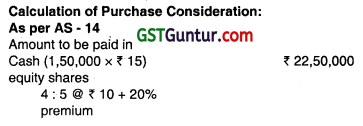

Note:
Amount paid to debenture holders will not be included in calculation of purchase consideration.
Question 59.
On 1st April 2018, Tina Ltd. take over the business of Rina Ltd. and discharged purchase consideration as follows:
(i) Issued 50,000 fully paid Equity shares of ₹ 10 each at a premium of ₹ 5 per share to the equity shareholders of Rina Ltd.
(ii) Cash, payment of ₹ 50,000 was made to equity shareholders of Rina Ltd.
(iii) Issued 2,000 fully paid 12% Preference shares of ₹ 100 each at par to discharge the preference shareholders of Rina Ltd.
(iv) Debentures of Rina Ltd. ( ₹ 1,20,000) will be converted into equal number and amount of 10% debentures of Tina Ltd.
Calculate the amount of Purchase consideration as per AS-14 and pass Journal Entry relating to discharge of purchase consideration in the books of Tina Ltd. (Nov 2018, 5 marks)
Answer:
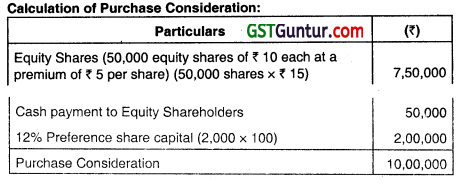
Note: As per AS 14. consideration for the amalgamation means the aggregate of the shares and other securities issued and the amount of the payment made in the form of cash or other assets by the transferee company to the shareholders of the transferor company. Thus, payments to debenture holders are not covered by the term ‘consideration.
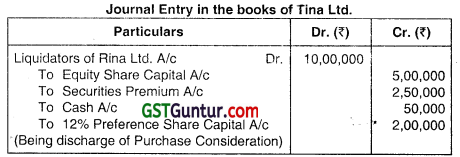
Question 60.
M/s XYZ Ltd. has three segments namely X. Y, Z. The total Assets of the Company are ₹ 10.00 crs. segment X has ₹ 2.00 crs., segment Y has ₹ 3.00 crs. and segment Z has 5.00 crs. deferred tax Assets included in the Assets of each segments are X- ₹ 0.50 crs., Y- ₹ 0.40 crs. and Z- ₹ 0.30 crs. The accountant contends that all the three segments are reportable segments. Comment. (Nov 2008, 5 marks)
Answer:
As per AS 17 ‘‘Segment Reporting”, segment assets do not include income tax assets. Therefore, the revised total assets are 8.8 crores (10 crors -(0.5+0.4+0.3). Segment X holds total assets of 1.5 crores (2 crores – 0.5 crores); Segment Y holds 2.5 crors (3 crores – CA crores); and Segment Z holds 4.7 crore (5 rore – 0.3 crores). Thus, all segments are reportable segments. As all the three segments hold more than 10% of the total assets.
Question 61.
ABC Limited has three seqm.nts viz. A. B and C. The total assets of the company is ₹ 15 Crores. The assets of Segment A is 1.85 Crores, Segment Bis 6.15 Crores and Segment C is ₹ 7.00 Crores. Assets of each segment include deferred tax assets of ₹ 0.50 Crores in A, ₹ 0.40 Crores in B and ₹ 0.30 Crores in C. The accountant of ABC limited contends that all segments are reportable segments. Based on segment assets criteria, determine the veracity of the contention of the accountant. (Nov 2014, 5 marks)
Answer:
Statement showing percentage of Segment net assets to Total assets of the company

As per AS 17 ‘Segment Reporting’, one of the basis of segment asset criteria for identification of a business segment or geographical segment as a reportable segment is when its segment assets are 10% or more of the total assets of all segments. Accordingly, the reportable segments will be segments B and C only. Therefore, the contention of the accountant that all the segments are reportable segments is not tenable.
Question 62.
Answer the following:
M/s Nathan Limited has three segments namely P, Q and R. The total assets of the company are ₹ 15 crores. Segment P has 4 ccoes, Segment Q has 6 crores and Segment R has 5 crores. Deferred tax assets included in the assets of each segments are P – ₹ 1 crore, Q – ₹ 0.90 crores and R- ₹ 0.80 crores. The accountant contends that all these three segments are
reportable segments. Comment. (May 2018, 5 marks)
Answer:
According to AS 17 “Segment Reporting”, segment assets do not include income tax assets.
Therefore the revised total assets are ₹ 12.3 crore [₹ 15 crores – (₹ 1 crore + ₹ 0.90 crore + ₹ 080 crore)],
Segment P holds total assets of ₹ 3 crores (₹ 4 crores- ₹ 1 crore);
Segment Q holds ₹ 5.1 crores (₹ 6 crores – ₹ 0.90 crores); and
Segment R holds ₹ 4.2 crores (₹ 5 cores – ₹ 0.80 crores).
Thus all the three segments hold more than 10% of the total assets, all Segments are reportable Segments.
![]()
Question 63.
Answer the following:
The accountant of Parag Limited has furnished you with the following data related to its Business Divisions:
| (₹ In Lacs) | |||||
| Division | A | B | C | D | Total |
| Segment Revenue | 100 | 300 | 200 | 400 | 1000 |
| Segment Result | 45 | -70 | 80 | -10 | 45 |
| Segment Assets | 39 | 51 | 48 | 12 | 150 |
You are requested to identify the reportable segments in accordance with the criteria laid down in AS 17. (Nov 2020, 5 marks)
Question 64.
The Senior Accountant of AMF Ltd. gives the following data regarding its five segments:
|
(₹ in lakhs) |
||||||
| Particulars | P (₹) |
Q (₹) |
R (₹) |
S (₹) |
T (₹) |
Total (₹) |
| Segment Assets | 80 | 30 | 20 | 20 | 10 | 160 |
| Segment Results | (190) | 10 | 10 | (10) | 30 | (150) |
| Segment Revenue | 620 | 80 | 60 | 80 | 60 | 900 |
The Senior Accountant is of the opinion that segment “P” alone should be reported. Is he justified in his view? Examine his opinion in the light of provision of AS-17 ‘Segment Reporting’. (Jan 2021, 5 marks)
Question 65.
From the foflowing information of a Company having two primary segments, prepare a statement classifying the same under appropriate heads:
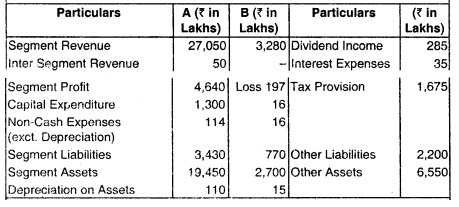
Answer:
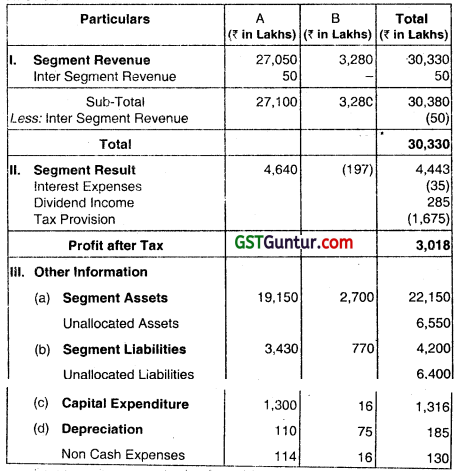
Question 66.
The Chief Accountant of Govind Ltd. gives the following data regarding its six segments: (₹ in Lakhs)
| Particular | A | B | C | D | E | F | Total |
| Segment Assets | 40 | 80 | 30 | 20 | 20 | 10 | 200 |
| Segments Results | 50 | -190 | 10 | 10 | -10 | 30 | -100 |
| Segment Revenue | 300 | 620 | 80 | 60 | 80 | 60 | 1200 |
The Chief Accountant is of is the opinion that Segment M and N alone should be reported. Is he justified in his view? Discuss.
Answer:
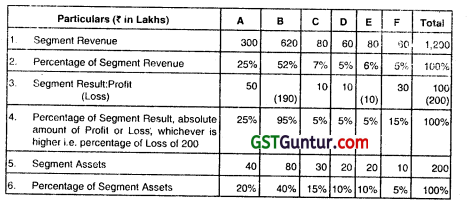

Note: S = Sales Condition, R = Result Condition, A = Assets Condition Conclusion: Therefore, the Reportable Segments are M. N, O, P. Q, and R, i.e. all the given segments.
Question 67.
Calculate the segment results of a manufacturing organization from the following information:
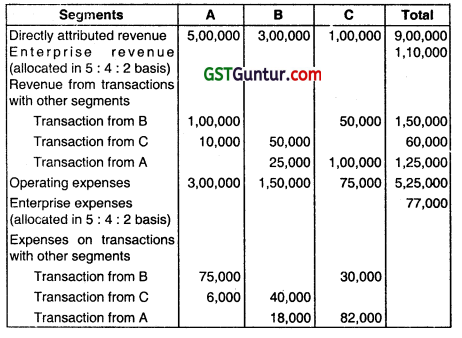
Answer:
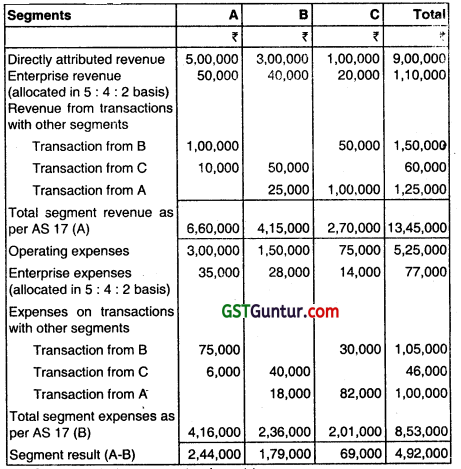
Question 68.
P Ltd. has 60% voting right in Q Ltd. Q Ltd has 20% voting right in R Ltd. Also, P Ltd. directly enjoys voting right of 14% in R Ltd. R Ltd. is a listed company and regularly supplies goods to P. Ltd. The management of R Ltd. has not disposed its relationship with P Ltd. How would you assess the situation from the viewpoint of AS-18 on Related Party Disclosures? (Nov 2007, Nov 2012, 4 marks)
Answer:
P Ltd. has direct economic interest in R Lid. to the extent of 14%. and through Q Ltd. (in which it is the majority shareholders) it has further control of 12% in R Ltd. (60% of Q Ltd.’s 20%). These two taker together (14% + 12%) make the total control of 26%.
AS 18 Related Party Disclosures, defines related party s one that has at any time during the reporting period, the ability to control the other party or exercise significant influence over the other party in making financial and / or operating decisions. Since, P Ltd. has total control of 26% (directly and indirectly by Q Ltd.) in R Ltd. which is less than half of the voting power of R Ltd., P Ltd. Is said to have significant influence over R Ltd. Also ¡I Is given in the question that R Ltd. is a listed company and regularly supplies goods to P Ltd. Hence, related party disclosure, as per AS-18, is required by R Ltd. in its financial statements, in respect of goods supplied to P Ltd.
Question 69.
Following transactions are disclosed as on 31st March 2018:
(i) Mr. Sumit. a relative of Managing Director, received remuneration of 2,10,000 for his services in the company for the period from 1st April 2017 to 30th June 2017. He left the service on 1 July, 2017, Should the relative be identified as on closing date i.e. on 31 -3-2018 for the purpose of AS-18.
(ii) Goods sold amounting to 50 lakhs to associate company during the 1st quarter ended on 30 June 2017. After that related party relationships ceased to exist. However, goods were supplied as was supplied to any other ordinary customer. Decide whether transactions of the entire year have to be disclosed as related party transactions. (Nov 2018, 5 marks)
Answer: –
(i) According to AS 18 on Related Party Disclosures, parties are considered to be related if at any time during the reporting period one party has the ability to control the other party or exercise significant influence over the other party in making financial and /or operating
decisions. Hence, Mr. Sumit, a relative of key management personnel should be identrfied as relative as at the closing date i.e on 31.03.2018.
(ii) As per AS 18, ‘Related Party Disclosures’, transactions of the company with its associate company for the first quarter ending on 30.06.2017 only are required to be disclosed as related party transactions. The transactions for the period In which related party relationship did not exist need not be reported.
Question 70.
Identify the related parties in the following cases as per AS-18
(i) Maya Ltd. holds 61% shares of Sheetal Ltd. Sheetal Ltd. holds 51% shares of Fair Ltd.
Care Ltd. holds 49% shares of Fair Ltd. (Give your answer Reporting Entity wise for Maya Ltd., Sheetal Ltd., Care Ltd. and Fair Ltd.)
(ii) Mr. Subhash Kumar is Managing Director of A Ltd. and also holds 72% capital of B Ltd. (B Ltd. is subsidiary of A Ltd.) (May 2019, 5 marks)
Answer:
(i) Reporting entity-Maya Ltd.
Sheetal Ltd. (Subsidiary) is a related party.
Fair Ltd. (Subsidiary) is a related party.
Reporting Entity-Sheetal Ltd.
Maya Ltd. (holding company) is a related party.
Fair Ltd. (subsidiary) is a related party.
Reporting Entity-Fair Ltd.
Maya Ltd. (holding company) is a related party.
Sheetal Ltd. (holding company) is a related party.
Care Ltd. (investor/investing party) is a related party.
Reporting Entity-Care Ltd.
Fair Ltd. (associate) is a related party.
(ii) Reporting Entity-A Ltd.
Mr. Subhash Kumar (Managing Director) ¡s a related party.
B Ltd. (subsidiary) is a related party.
Reporting Entity – B Ltd.
Mr. Subhash Kumar (investor) is a related party.
A Ltd. (holding company) is a related party.
Question 71.
Sun Ltd. sold goods for 50 Iakhs to Moon Ltd. during financial year ended 31st March 2017 at normal selling price followed by Sun Ltd. The Managing Director of Sun Ltd. holds 75% shares of Moon Ltd. The Chief accountant of Sun Ltd. contends that these sales need not require a different treatment from the other sales made by the company and hence no disclosure is necessary as per the accounting standard. You are required to examine and advise whether the contention of the Chief Accountant correct?
Answer:
As per AS-18 ‘Related Party Disclosures’, enterprises over which a key management personnel is able to exercise significant influence are related parties. This includes enterprises owned by directors or major shareholders of the reporting enterprise and enterprise that have a member of key management in common with the reporting enterprise.
In the given case, Sun Ltd. and Moon Ltd. are related parties and hence disclosure of transaction between them s required irrespective of whether the transaction was done at normal selling price. Hence ‘he contention of Chief Accountant of Sun Ltd. is wrong.
Question 72.
B & P Ltd. availed a tease from N & L Ltd. The conditions of the lease terms are as under:
(i) Lease period is 3 years, In the beginning of the year 2009, for equipment costing ₹ 10,00,000 and has an expected useful life of 5 year
(ii) The Fair market value is also ₹ 10,00,000.
(iii) The property reverts back to the lessor on termination of the lease.
(iv) The unguaranteed value ¡s estimated at ₹ 1,00,000 at the end of the year 201 1.
(v) 3 equal annual payments are made at the end of each year. Consider IRR = 10%
The present value of ‘ 1 due at the end of 3d year at 10% rate of interest is ₹ 0.7513.
The present value of annuity of 1 due at the end of 3rd year at 10% IRR is ₹ 2.4868.
State whether the lease constitute finance lease and also calculate unearned Finance income. (May 2010, 4 marks)
Answer:
(i) Computation of annual lease payment to the lessor
| Particulars | ₹ |
| Cost of equipment | 10,00,000 |
| Unguaranteed residual value | 1 ,00,000 |
| Present value of residual value after third year @ 10% (₹ 1,00,000 x 0.7513) | 75,130 |
| Fair value to be recovered from lease payments (₹ 10,00,000 – 75,130) | 9,24,870 |
| Present value of annuity for three years is 2.4868 Annual lease payment = 9,24,870/2.4868 |
3,71,911.70 |
The present value of lease payment i.e. ₹ 9,24,870 equals 92.48% of the fair market value i.e., ₹ 10,00,000. As the present value of minimum lease payments substantially covers the initial fair value of the leased asset and lease term (i.e.3 years) covers the major part of the life of asset (i.e. 5 years) Therefore, it constitutes a finance lease.

Question 73.
Lessee Ltd. took a machine on lease f rocn Lessor Ltd., the fair value being ₹ 7,00,000. The economic life of machine as well as the lease term is 3 years. At the end of each year Lessee Ltd. pays ₹ 3,00,000. The Lessee has guaranteed a residual value of ₹ 22,000 on expiry of the lease to the Lessor. However, Lessor Ltd., estimates that the residual value of the machinery will be only 15,000. The implicit rate of return is 15% p.s. and present value factors at 15% are 0.869, 0.756 and 0.657 at the end of first, second, and third years respectively. Calculate the value of machinery to be considered by Lessee Ltd. and the finance charges in each year. (May 2011, 8 marks)
Answer:
Provision:
According to AS 19 “Leases”, the lessee should recognize the lease as an asset and a liability at the Inception of a finance lease. Such recognition should be at an amount equal to the fair value of the leased asset at the Inception of lease. However, if the fair value of the leased asset exceeds the present valuo of minimum lease payment from the standpoint of the lessee,
the amount recorded as an asset and liability should be the present value of minimum lease payments from the standpoint of the lessee.
Value of machinery:
In the given question, fair value of the machinery is ₹ 7,00,000 and the net present value of minimum lease payments is ₹ 6,99,054 (Note 1). As the present value of the machine is less than the fair value of the machine, the machine will be recorded at value of ₹ 6,99,054.
Computation of finance charges for each year

Note 1: Present value of minimum lease payments: Annual lease rental x PV factor + Present value of guaranteed residual value
= ₹ 3,00.000 x (0.869 + 0.756 0.657) + ₹ 22,000 x (0.657)
= ₹ 6,84,600 + ₹ 14,454 = ₹ 6,99054.
Note 2: The difference between this figure and guaranteed residual value (₹ 22,000) is due to approximation in computing the interest rate implicit in the lease.
Question 74.
Answer the following:
An equipment having expected useful life of 5 years, Is leased for 3 years. Both the cost and the fair value of the equipment are ₹ 6.00,000. The amount will be paid in 3 equal Instalments and at the termination of lease, lessor will get back the equipment. The unguaranteed residual value at the end of 3 years is ₹ 60,000. The IRR of the investment is 10%. The present value of annuity factor of ₹ 1 due at the end of 3 year at 10% IRR is ₹ 24868. The present value of ₹ 1 due at the end of 3 year at 10% rate of interest is 07513. State with reason whether the lease constitutes finance lease and also compute the unearned finance income. (Nov 2011, 5 marks)
Answer:
(i) Determination of Nature of Lease:
Present value of residual value at the end of 3rd year= ₹ 60,000 x 0.7513 = ₹ 45,078
Present value of lease payments= ₹ 6,00,000 – ₹ 45,078 = ₹ 5,54,922
The percentage of present value of lease payments to fair value of the equipment is (₹ 5,54,922/₹ 6,00,000) x 100 = 92.487%
Since it substantially covers the major portion of the lease payments, the lease Constitutes a finance lease.
Assumption:
It is assumed that the fair value of the leased equipments is equal to the present value of minimum lease payments.
(ii) Calculation of Unearned Finance Income:
Annual lease payment = ₹ 5,54922 /2.4868 =₹ 2,23,147 (approx)
Gross investment in the lease = Total minimum lease payment + unguaranteed residual value
= (₹ 2,23,147 x 3) + ₹ 60,000 = ₹ 6,69,441 + ₹ 60,000 =₹ 7,29,441
Unearned finance income = Gross investment – Present value of minimum lease payments and unguaranteed residual value = ₹ 7,29.441 – ₹ 6,00,000 =₹ 1,29,441
Question 75.
Answer the following:
X Ltd. sold JCB Machine having WDV of ₹ 50 Lakhs to V Ltd. for ₹ 60 Lakhs and the same JCB was leased back by Y Ltd. to X Ltd. The lease is operating lease. Comment according to relevant Accounting Standards If
(i) Sale price of ₹ 60 Lakhs is equal to fair value.
(ii) Fair value is ₹ 50 Lakhs and sale price is ₹ 45 Lakhs.
(iii) Fair value is ₹ 55 Lakhs and sale price is ₹ 62 Lakhs.
(iv) Fair value is ₹ 45 Lakhs and sale price is ₹ 48 Lakhs. (2012 May, 4 marks)
Answer:
According to AS 19, following will be the treatment In the given Situations:
(i) lithe sales price of ₹ 60 lakhs is equal to fair value. X Ltd. should immediately recognize the profit of ₹ 10 lakhs (i.e. 60 – 50) ¡n Its books.
(ii) If the fair value of leased JCB machine is ₹ 50 lakhs & sales price is ₹ 45 lakhs. then loss of ₹ 5 Lakhs (50 – 45) to be immediately recognized by X Ltd. in its books provided loss is not compensated by future lease payments.
(iii) li the fair value is ₹ 55 Iakhs & sales price is ₹ 62 lakhs. profit of ₹ 5 lakhs (55 – 50) to be immediately recognized by X Ltd. in its books and balance profit of ₹ 7 lakhs (62 – 55) is to be amortised/deferred over lease period.
(iv) lithe fair value is ₹ 45 lakhs & sales price is ₹ 48 lakhs, then the loss of ₹ 5 lakhs (50-45) to be immediately recognized by X Ltd. in its books and profit of ₹ 3 lakhs (48- 45) should be amortised/deterred over lease period.
Question 76.
Define the term, Finance Lease. State any three situations when a lease would be classified as finance lease. (Nov 2012, 4 marks)
Answer:
As per AS-19 Leases, a finance lease Is a lease that transfers substantially all the risks and rewards incident to ownership of an asset. As per para 8 of the standard, classification of lease into a finance lease or an operating lease depends on the substance of the transaction rather than its form. Three situations which would normally lead to a lease being classified as a finance lease are:
(i) The lessor transfers ownership of the asset to the lessee by the end of the lease term;
(ii) The lessee has the option to purchase the asset at a price which is expected to be sufficiently lower than the fair value at the date the option becomes exercisable such that, al the inception of the lease, It is reasonably certain that the option will be exercised;
(iii) The lease term is for the major part of the economic life of the asset even if the title is not transferred.
Other situations when a lease would be classified as finance lease:
(i) At the inception of the lease the present value of the minimum lease payments amounts to at least substantially all of the fair value of the leased as set; and
(ii) the leased asset is of a specialized nature such that only the lessee can use it without major modifications being made. Situations which individually or in combination could also lead to a lease being classified as a finance lease are:
(iii) If the lessee can cancel the lease, the lessor’s losses associated with the cancellation are borne by the lessee,
(iv) gains or losses from the fluctuation in the fair value of the residual fall to the lessee, and
(v) the lessee can continue the lease for a secondary period at a rent which is substantially lower than market rent.
![]()
Question 77.
Answer the following:
Annual lease rent = ₹ 40,000 at the end of each year
Lease period = 5 years
Guaranteed residual value = ₹ 14,000
Fair value at the inception (beginning) of lease = ₹ 1,50,000
Interest rate implicit on lease is 12.6%. The present value factors at 12.6% are 0.89, 0.79, 0.7, 0.622, 0.552 at the end of first, second, third, fourth and fifth year respectively.
Show the Journal entry to record the asset taken on finance lease in the books of the lessee. (Nov 2012, 4 marks)
Answer:

Question 78.
Answer the following:
Classify the following Into either operating or finance lease:
(i) Lessee has option to purchase the asset at lower than fair value, at the end of lease term:
(ii) Economic life of the asset is 7 years, lease term is 6 years, but asset is not acquired at the end of the lease term;
(iii) Economic life of the asset is 6 years, lease term is 2 years, but the asset is of special nature and has been procured only for use of the lessee,
(iv) Present value (PV) of Minimum lease payment (MLP) = X”. Fair value of the asset is “Y”. (Nov 2013, 4 marks)
Answer:
(i) Finance lease It becomes certain at the inception of lease itself that the option will be exercised.
(ii) It will be classified as finance lease since a substantial portion of the his of the asset s covered by the lease term. .
(iii) Since the asset is procured only for the use of lessee, it is a finance lease.
(iv) Where X = 4, or where X substantially equals 4. it is a finance lease.
Question 79.
Answer the following: :
What do you understand by the term lnterest rate implicit on lease”? Calculate the interest rate implicit on lease from the following details:
Annual Lease Rent: 80,000 at the end of each year
Lease Period: 5 Years
Guaranteed Residual Value: 40,000
Unguaranteed Residual Value: 24,000
Fair Value at the inception of the lease: 3,20,000
Discounted rates for the first 5 years are as below:
At 10% 0.909, 0.826, 0.751, 0.683, 0.621,
At 14°, 0.877, 0.769, 0.675, 0.592, 0.519, (May 2014, 5 marks)
Answer:
According to AS- 19 ‘Leases’ the interest rate implicit in the ease is the discount rate that, at the inception of the lease, causes the aggregate present value of: .
(a) the minimum lease payments under a finance lease from the standpoint of the lessor; and
(b) any unguaranteed residual value accruing to the lessor, to be equal to the fair value of the leased asset.
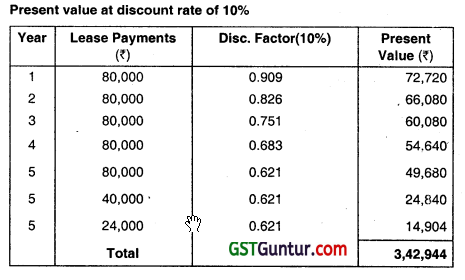

Question 80.
Answer the following:
A machine having expected useful life of 6 years, is leased for 4 years. Both the cost and the fair value of the machinery are ₹ 7,00,000. The amount will be paid in 4 equal Instalments and at the termination of lease, lessor will get back the machinery. The unguaranteed residual value at the end of the 4th year is ₹ 70,000. The IRR of the investment is 10%. The present value of annuity factor of ₹ 1 due at the end of year at 10% IRR is 3.169. The present value of ₹ 1 due at the end of 4th year at 10% rate of interest is 0.683. State with reasons whether the lease constitutes finance lease and also compute the unearned finance income. ( Nov 2014, 5 marks)
Answer:
(i) The lease term is 66.67% of asset’s useful life. Also present value of lease payments is around 93% of the lair value, constituting substantial portion of the fair value.
Therefore, the lease Is a financial lease on the basis of calculation below:
(a) Present value of Uriguaranteed Residual Value (UGRV):
= 70,000 x 0.683 = ₹ 47,810
(b) Present value of Lease Payments (PV of MLP):
= 7,00,000 -47,810 = ₹ 6,52,190
(C) % of PV of MLP to fair value:
= 100 = 93.17%
Since it substantially covers the major portion of lease payment and life of the assit, the lease constitutes a financial lease.
(ii) Computation of Unearned Finance Income:
Annual Lease Payments = \(\frac{\text { PV of Lease Payments }}{\text { Annuity factor for } 3 \text { years at } 20 \%} \)
= \(\frac{6,52,190}{3.169}\) = ₹ 2,05,803 p.a

Question 81.
Answer the following:
State any four situations when a lease would be classified as Finance Lease. (May 2015, 4 marks)
Answer:
Situation when a lease would be classified as finance lease:
Finance Lease is a lease, which transfers substantially all the risks and rewards incidental to ownership of an asset to the lessee by the lessor but not the legal ownership. As per AS-19, in following situations, the lease transactions would be classified as Finance lease:
- When there is transfer of ownership in finance lease of the asset to the lessee by the end of the lease term.
- When option to purchase the asset is available to the lessee, at a price which is sufficiently lower than the fair value at the date the option becomes exercisable such that, at the inception of the lease, it is reasonably certain that the option will be exercised.
- When lease term is for the major part ot the economic life of the asset even if title is not transferred.
- When present value of minimum ease payment at the inception of the lease amounts to at least substantially all of fair value, of leased asset (i.e. PV of MLP Fair value approx).
Question 82.
Answer the following:
Aksat International Limited has given a machinery on lease for 36 months and its useful lite is 60 months. Cost and fair market value of the machinery is ₹ 5,00,000. The amount will be paid in 3 equal annual installments and the lessee will return the machinery to lessor at termination of lease. The unguaranteed residual value at the end of 3 years is ₹ 50,000. IRR of investment is 10% and present value of annuity factor of ₹ 1 due at the end of 3 years at 10% IRR is 2.4868 and present value of ₹ 1 due at the end of 3’ year at 10% IRR is 0.7513. You are required to comment with reason whether the tease constitute finance lease or operating lease. If it is finance lease, calculate unearned finance income. (Nov 2015, 5 marks)
Answer:
Determination of Nature of Lease
Present value of unguaranteed residual value at the end of 3rd year = ₹ 50,000 × 0.7513 = ₹ 37,565
Present value of lease payments = ₹ 5,00,000 – ₹ 37.565 = ₹ 4,62.435
The percentage of present value of lease payments to fair value of the
equipment is (₹ 4,62,435/ ₹ 5,00,000) x 100 = 92.487%.
Since, lease payments substantially covers the major portion of the fair value; the lease constitutes a finance lease.
Calculation of Unearned Finance Income
Annual lease payment 4,62,435/ 2.4868 = ₹ 1,85,956 (approx.)
Gross investment in the lease Total minimum lease payments + unguaranteed residual value
= (₹ 1,85,956 x 3) + ₹ 50,000
= ₹ 5,57,868 + ₹ 50,000
= ₹ 6,07,868
Unearned finance income = Gross investment – Present value of minimum lease payments and unguaranteed residual value
₹ 6,07,868 – ₹ 5,00,000
= ₹ 1,07,868
Question 83.
A Ltd. sold JCB having WDV of ₹ 20 lakhs to B Ltd. for ₹ 24 lakhs and the same JCB was leased back by B Ltd. to A Ltd. The lease is operating lease. In context of Accounting Standard 19 Leases explain the accounting treatment of profit or loss in the books of A Ltd. if
(i) Sale price of ₹ 24 lakhs is equal to fair value.
(ii) Fair value is ₹ 20 lakhs and sale price is ₹ 24 lakhs
(iii) Fair value is ₹ 22 lakhs and sale price is ₹ 25 lakhs.
(iv) Fair value is ₹ 25 lakhs and sale price is ₹ 18 lakhs
(v) Fair value is ₹ 18 lakhs and sale price is ₹ 19 lakhs. (May 2018, 5 marks)
Answer:
Following will be the treatment in the given cases:
(i) When sales price of ₹ 24 lakhs s equal to fair value, A Ltd. should immediately recognise the profit of ₹ 4 lakhs (i.e. 24-20) in its books.
(ii) When fair value is ₹ 20 lakhs and sales price is ₹ 24 lakhs then, profit of ₹ 4 lakhs is to be deterred and amortised over the lease period.
(iii) When fair value is ₹ 22 lakhs and sales price is ₹ 25 lakhs, profit of ₹ 2 lakhs (22-20) to be immediately recognised in its books and balance profit of ₹ 3 lakhs (25-22) is to be amorised / deferred over lease period.
(iv) When fair value of leased machinery is ₹ 25 lakhs and sales price is ₹ 18 lakhs. then the loss of ₹ 2 lakhs (20-18) to be immediately recognised by A Ltd. in its books provided loss is not compensated by future lease payment.
(v) When fair value is ₹ 18 lakhs and sales price is ₹ 9 lakhs, then the loss of ₹ 2 lakhs (20-18) to be immediately recognised by A Ltd. in, its books and profit of ₹ 1 lakh (19-18) should he amortised /dqterred over lease period.
Question 84.
Jaya Ltd. took a machine on lease from Deluxe Lia., the fair value being ₹ 11,50,000, Economic the of the machine as well as lease term is 4 years. At the end of each year. lessee pays ₹ 3,50,000 to lessor. Jaya Ltd. has guaranteed a residual value of ₹ 70,000 on expiry of the lease to Deluxe Ltd., however, Deluxe Ltd. estimates that residual value will be only ₹ 25,000. The implicit rate of return is 10% p.a. and present value factors at 10% are 0.909 0.826,0.751 and 0.683 at the end of 1st, 2nd, 3rd and 4th year respectively. Calculate the value of machinery to be considered by Jaya Ltd. and the value of the lease liability as per AS-19. (May 2019, 5 marks)
Answer:
As per Para 11 of AS 19, “Leases”, the lessee should recognize the tease as an asset and a liability at the inception of a finance lease. Such recognition should be at an amount equal to the fair value of the leased asset at the inception of loose. However, if the fair value of the leased asset exceeds the present value of minimum lease payment from the standpoint of the lessee, the amount recorded as an asset and liability should be the present value of minimum lease payments from the standpoint of the lessee.
Value of Machinery:
In the given case, fair value of the machinery is ₹ 11,50,000 and the net present value of minimum lease payments is ₹ 11,56,960. As the fair value of machine is less than the present value of machine, the machine will be recorded at value of ₹ 11.50,000.
Present value of Minimum lease Payments =
(Annual lease rental x PV factor) + PV of guaranteed residual value.
= ₹ 3,50,000 x (0.909 + 0.826 + 0.751 + 0.683) +₹ 70,000 x 0.683
=₹ 11,56,960
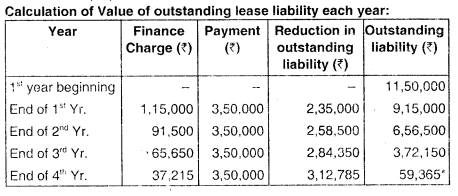
Note:
The difference between this figuro and guaianteed residual vaue ₹ 70,000 is due to approximation in computing the intorest rato implicit in the lease.
Question 85.
Answer the following:
(a) X Ltd. is a group engaged in manufacture and sale of industrial and FMCG products. One of their division also deals in Leasing of properties – Mobile Towers, The accountant showed the rent arising from the leasing of such properties as other income in the Statement of Profit and Loss. Comment whether the classification of the rent income made by the accountant is correct or not in the light of Schedule Ill to the Companies Act. 2013. (Nov 2019, 5 marks)
Answer:
According to para 4 of the ‘General Instructions for preparation of Statement of Profil and Loss’ given in the Schedule Ill to the Companies Act, 2013, other income’ does not include operating income. Again the term “Revenue from operations has not been defined under Schedule III to the Companies Act, 2013. But as per Guidance Note on Schedule Ill to the Companies Act. 2013 this would include revenue arising from a company’s operating activities i.e. either its principal or ancillary revenue-generating activities. Whether a particular income constitutes Revenue from operations or “other income” is to be decided based on the facts of each case and detailed understanding of the company’s activities.
The classification of income would also depend on the purpose for which the particular asset is acquired or held. In the given case, X Ltd. is a group engaged in manufacture and sale of industrial and FMCG products and its ore of the division deals in leasing of proparhes- Mobile Towers Since its one division is continuously engaged in leasing of properties, it shall be considered as its principal or ancillary revenue-generating activities. Therefore, the rent arising from such leasing shall be shown under the head Reverue from operations” and not as “Other Income”.
Thus, the presentation of rent arising from the leasing of such properties as “other income” in the statement of Profit and Loss is not correct. It should be shown under the head ‘Revenue from operations”.
Question 86.
Answer the following:
(e) Classify the following into either operating lease or finance lease with reason:
1. Economic life of asset is 10 years, lease term is 9 years, but asset is not acquired at the end of lease term.
2. Lessee has option to purchase the asset at lower than fair value at the end of lease term.
3. Lease payments should be recognized as an expense in the statement of Profit and Loss of a lessee.
4. Present Value (PV) of Minimum Lease Payment (MLP) = Fair value of the àsset is ‘Y”. And X = Y
5. Economic life of the asset is 5 years, lease term is 2 years, but the asset is of special nature and has been procured only for use of the lessee. (Nov 2019, 5 marks)
Answer:
1. The lease wilt be classified as a finance lease, since a substantial portion of the fife of the asset is covered by the lease term.
2. If it becomes Certain at the inception of lease itself that the option will be exercised by the lessee, it is a Finance Lease.
3. If lease payments is recognised as an expense in the statement of profit and loss of a lessee, then it is considered as an operating lease.
4. The lease is a finance lease if X = Y, or where X Substantially equals Y.
5. Since the asset is procured only for the use of lessee, it is a finance lease.
Question 87.
Answer the following:
(a) X Ltd. sold machinery having WDV of ₹ 300 lakhs to Y Ltd. for ₹ 400 lakhs and the same machinery was leased back by Y Ltd. to X Ltd. The lease back arrangement is operating lease. Give your comments in the following situations:
(i) Sale price of ₹ 400 Iakhs is equal to fair value.
(ii) Fair value is ₹ 450 lakhs.
(iii) Fair value is ₹ 350 lakhs and the sale price is ₹ 250 lakhs.
(iv) Fair value is ₹ 300 laktis and sale price is ₹ 400 lakhs.
(v) Fair value is ₹ 250 lakhs and sale price is ₹ 290 lakhs. (Jan 2021, 5 marks)
Question 88.
XYZ Ltd. has taken an asset on lease from ABC Ltd. for a period of 3 years. Annual Lease Rentals are 6 Lakhs payable at the end of every year. The Residual Value guaranteed by XYZ is ₹ 2 Lakhs where as ABC expects the estimated salvage value to be ₹ 5 Lakhs at the end of the lease term li the Fair Value of the asset at the lease inception is ₹ 15 Lakhs and the interest rate implicit in the lease is 12%, compute the Net Investment in the Lease from the viewpoint of ABC Ltd. and the annual Finance Income.
Answer:
- Minimum Lease Payments (MLP) = 6 Lakhs x 3 years = ₹ 18,00,000
- Guaranteed Residual Value (GRV) ₹ 2,00,000 Given
- MLP from the viewpoint of the Lessor (XYZ) = MLP as above + GRV = ₹ 20,00,000
- Unguaranteed Residual Value (URV) = Total Residual Value GRV = ₹ 3,00,000
- Gross Investment in the MLP for Lessor + URV Lease = ₹ 23,00,000
- PV of MLP, GRV and LJRV As per computation below = ₹ 17,97,040
- Unearned Finance Income (5) – (6) ₹ 5,02,960
- Net Investment in the Lease (5) – (7) ₹ 17,97,040
Note: PV of Gross Investment in the Lease is computed as under:
PV of MLP = ₹ 6,00,000 x PVF at 12% for 3 years = ₹ 14,41,140
₹ 6,00,000 x (0.8929 +07972 + 0.7118) =
PV of (GRV + URV) = ₹ 5.00,000 x PVF at 12% for year 3 =
₹ 5,00,000 x 0.7118= ₹ 3,55,900
Total of the above ₹ 17,97,040
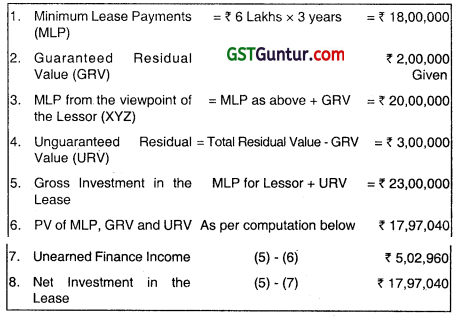
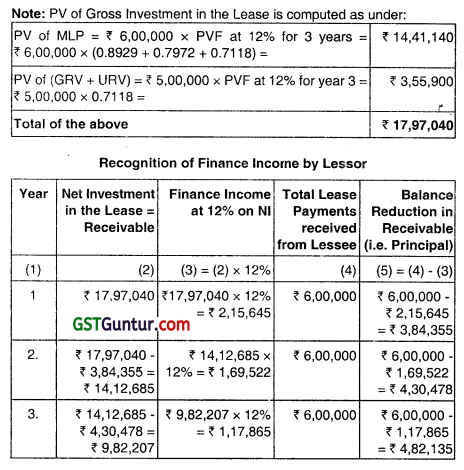


Question 89.
ABC Silk Mills leased its looms to XYZ Looms Ltd. for a period of five years from 1st April 2016, for a lumpsum lease of ₹ 10,50,000 payable n full in advance. The Lessor agreed to incur the expenditure for Repairs and Maintenance of the looms which were as under: Financial Year 2016- 2017 ₹ 4,700, Financial Year 2017-2018 ₹ 5,200. WDV of the Looms on 01.04.2016 was 4,60,000 and depreciation at 33 1/3% was to be charged. Pass Journal Entries in the books of the Lessor. Show relevant entries in the P & L A/c and the Balance Sheet for the year 2016-2017, If the Lessor closes its account on 31st March every year.
Answer:
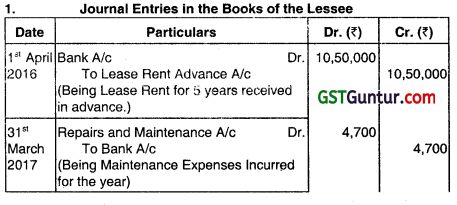

Question 90.
Lease Ltd. has an asset of 1 Lakh. which it depreciates at 10% on SLM method. At the end of the 5th year, it sells the asset at ₹ 60,000 (Fair Value) and leases it back for the remaining useful life of 5 years. Lessee Ltd. agrees to pay at the end of each of the 5 years, a Lease Rental of ₹ 15,000 and guarantees a Residual Value of ₹ 6,000 at the end of the lease term. Lessee’s Incremental borrowing rate is 10%. The PV of ₹ 1 at 10% at the end of 5th year is 0.62, and annuity is 3.79. Advice on accounting in the books of both the Lessor and Lessee Ltd.
Answer:
A. In the books of the Lessee:
1. Since SLM depreciation is 10%, useful life is taken as 10 years. Since the lease period covers the balance useful life of the asset, it is a Finance Lease.
2. PV of MLP & GRV = (3.79 x 15,000) + (0.62 x 6,000) = ₹ 60,570.
3. The asset should be capitalized at – (a) Fair Value ₹ 60,000, or (b) PV of MLP & GRV ₹ 60,570, whichever is lower. Hence, Cost of Asset in Lessor’s Books = ₹ 60,000.
4. Depreciation to be charged for the next 5 years
= \(\frac{\text { Cost less Residual Value }}{\text { Useful Life }}=\frac{₹ 60,000-₹ 6,000}{5 \text { years }}\) = ₹ 10,800 p.a
5. Profit on Sale and Lease Back = Revised Book Value Old Book
Value = ₹ 60000 – ₹ 50,000= ₹ 10,000 pa. .
This Profit will be credited to P & L Nc in the next 5 years. in proportion to the depreciation charge. In this case. ₹ 2,000 pa. will be credited to the P & L A/c over the next 5 years. (Since Depreciation is constant on SLM basis)
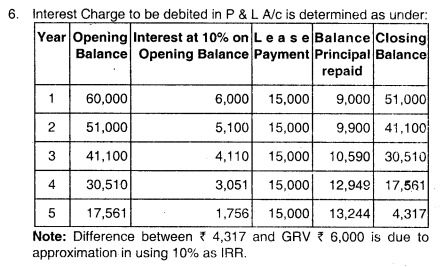
B. In the books of the Lessor: Tho Lessor makes an investment of ₹ 60,000 in respect of which he receives ₹ 75,000 (at ₹ 15,000 p.a.) over the next 5 years and also a Residual Value of ₹ 6,000. This gives him an IRR Of 9.98%, which will be recognized as follows:


![]()
Question 91.
ABC Ltd. took a machine on lease from XYZ Ltd., the fair value being 10,00,000. The economic life of the machine, as well as the lease term, is 4 years. At the end of each year. ABC Ltd. pays ₹ 3,50.000. The lessee has guaranteed a residual value of ₹ 40,000 on expiry of the lease to the lessor. However, XYZ Ltd. estimates that the residential value of the machinery will be 35,000 only. The implicit rate of return is 16% and PV factors at 16% for year 1 year 2, year 3, and year 4 are 0,8621, 0.7432, 0.6407 and 0.5523 respectively. You are required to calculate the value & machinery to be considered by ABC Ltd. and the finance charges for each year.
Answer:
Aa per AS-19 “Leases”, the lessee should recognize the lease as an asset and a liability all the inception of a finance lease. Such recognition should be at an amount equal to the fair value of the leased asset at the inception of ease However, if the fair value of the leased asset exceeds the present value of minimum lease payment from the standpoint of the lessee, the
amount recorded as an asset and liability should be the present value of minimum lease payments from the standpoint of the lessee.
Value of machinery
In the given case, fair value of the machinery is ₹ 10,00,000 and the net present value of minimum lease payments is ₹ 10,01,497 (Refer working Note). As the present value of the machine is more than the fair value of the machine, the machine and the corresponding liability will be recorded at fair value of ₹ 10,00,000
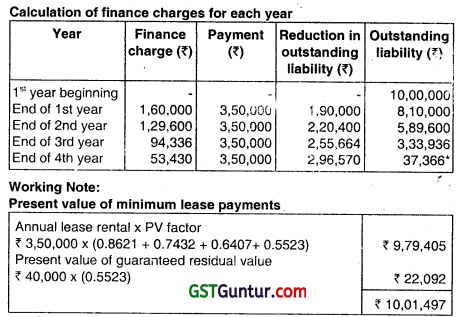
Question 92.
Answer the following
(i) From the following information relating to Y Ltd. Calculate Earnings Per Share (EPS):
₹ in Crore,
Profit before VPS Payments but alter depreciation 75.00
Depreciation 10.00
VRS payments 32.10
Provision for taxation 10.00
Fringe benefit tax 5.00
Paid up Share Capital (Shares of 10 each fully Paid) 93.00. (Nov 2007, 4 marks)
Answer:
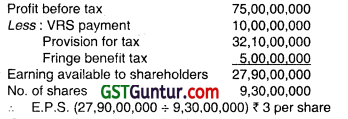
Question 93.
Answer the following:
From the following information relating to X Ltd. calculate Diluted earning per share as per AS-20:
Net profit for the current year ₹ 2,00,00,000
Number of equity shares outstanding ₹ 40,00,000
Basic earning per share ₹ 5,00
Number of 11% convertible debentures of ₹ 100 each 50,000
Each debenture is convertible into 8 equity shares.
Interest expense for the current year ₹ 5,50,000
Tax saving relating to interest expense (30%) ₹ 1,65,000 (May 2009, 4 marks)
Answer:
Adjusted Net profit for the current year
= 2,00,00,000 + 5,50,000 – 1,65,000 = ₹ 2,03,85,000
Number of equity shares resulting from conversion of deoentures
= 50,000 x 8 = 4,00,000 equity shares
Total number of equity shares resulting from coiversion of debentures
= 4,00,000 + 4,00,000 = 44,00,000 shares
Diluted Earnings per share = \(\frac{₹ 2,03,85,000}{44,00,000} \)
= ₹ 4.63 (Approximately)
Question 94.
Answer the following:
Compute Basic earnings per share from the following information:
| Date | Particulars | No. of Shares |
| 1st April, 08 | Balance at the beginning of the year | 1,500 |
| 1st August, 08 | Issue of shares for cash | 600 |
| 31st March, 09 | Buy back of shares | 500 |
Net profit for the year ended 31st March 2009 was ₹ 2,75,000. (Nov 2009, 5 marks)
Answer:


Question 95.
Answer the following:
Ram Ltd. had 12,00,000 equity shares on April, 1, 2009. The company earned a profit of ₹ 30,00,000 during the year 2009-10. The average fair value per share during 2009-10 was 25. The company has given share option to its employees of 2,00000 equity shares at option price of 15. Calculate basic E.P.S. arid diluted E.P.S. (Nov 2010, 4 marks)
Answer:
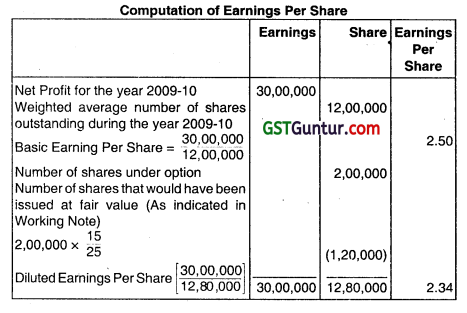
Working Note:
The earnings have not increased as the total number of shares has been increased only by the number of shares (80,000) deemed for the purpose of the computation to have been issued for no consideration.
Question 96.
Answer the following:
The following information ¡s available for Raja Ltd. for the accounting year 2009-10 and 2010-11.
Net Profit: Year 2009 -10 ₹ 25,00,000
Year 2010 -11 ₹ 40,00,000
No. of shares outstanding prior to right issue 12,00,000 shares.
Right issue: One rew share for each three outstanding e. 400,000 shares
: Right issue Price ₹ 22
: Last date of exercise rights 30-6-2010
Fair rate of one equity share immediately prior to exercise of rights on 30-6-2010 = ₹ 28
You are required to compute the basic earnings per share for the years 2009-10 and 2010-11 (May 2011, 5 marks)
Answer:
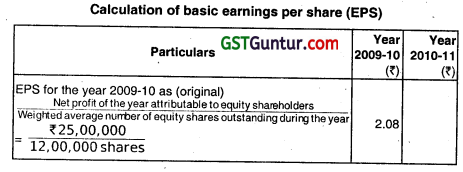

Note: The number of equity shares to be used in calculating basic earnings per share for periods prior to the rights issue is the number of equity shares outstanding prior to the issue, multiplied by the adjustment factor. The adjustment factor has been calculated as in Working Note 2.
Working Notes:
1. Calculation of theoretical ex-rights fair value per share

= \(\frac{(₹ 28 \times 12,00,000 \text { shares })+(₹ 22 \times 4,00,000 \text { shares })}{12,00,000 \text { shares }+4,00,000 \text { shares }}\) = ₹ 26.50
2. Calculation of adjustment factor
= \(\frac{\text { Fair value per share prior to exercise of rights }}{\text { Theoretical ex right value per share }} \)
= \(\frac{₹ 28}{₹ 26.5}\) = 1.06 approx
![]()
Question 97.
Answer the following:
Explain the concept of Weighted average number of equity shares outstanding during the period. State how would you compute, based on AS-20, the weighted average number of equity shares in the following case:
No. of Shares
1st April. 2011 Balance of Equity Shares 4.80000
31st August. 2011 Equity shares issued for cash 3,60.000
1st February 2012 Equity shares bought back 1,80,000
31st March 2012 Balance of equity shares 60,000 (May 2012, 2½ marks)
Answer:
(a) Provision:
According to Para 16 of AS-20, the weighted average number of equity shares outstanding during the period reflects the fact that the amount at any time, Hence. For the purpose of calculating basic or diluted earnings per share, the number of equity shares should be the weighted average number of equity snares outstanding during the period.

Question 98.
Answer the following:
(a) Net profit for the year 2012: ₹ 24,00,000
Weighted average number of equity shares outstanding during the year 2012:10,00,000
Average Fair value of one equity share during the year 2012: ₹ 25.00
Weighted average number of shares under option during the year 2012: 2,00.000 Exercise price for shares under option during the year 2012: ₹ 20.00
Compute Basic and Diluted earning per share. (May 2013, 5 marks)
Answer:
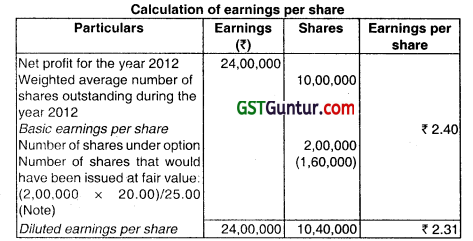
Note: The earnings have not been increased as the total number of shares has been increased only by the number of shares (40,000) deemed for the purpose of computation to have been issued for no consideration.
Question 99.
Answer the following:
The following information is available for AB Ltd. for the accounting year 2012-13 and 2013-14:
Net profit for ₹
Year 2012-13 22,00,000
Year 2013-14 30,00,000
No. of shares outstanding prior to right issue 10,00,000 shares.
Right issue: One new share for each five shares Outstanding i.e. 2,00,000 shares.
: Right Issue price ₹ 25
: Last date to exercise right 31 July, 2013
Fair value of one equity share immediately prior to exercise of rights on 31.07,2013 is ₹ 32.
You are required to compute
(i) Basic earnings per share for the year 2012-13.
(ii) Restated basic earnings per share for the year 2012-13 for right issue.
(iii) Basic earnings per share for the year 2013-14. (May 2014, 5 marks)
Answer:
(i) Computation of Basic Earning per share for 2012-13.
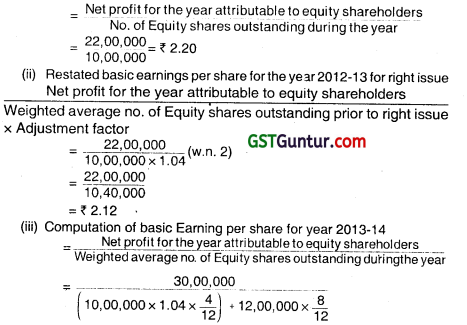
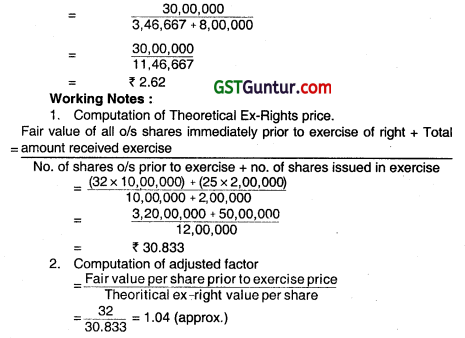
Question 100.
Answer the following:
M/s. A Ltd. had 8,00.000 Equity Shares outstanding on 1st April 2013. The Company earned a profit of ₹ 20.00,000 during the year 2013 – 14. The average fair value per share during 2013- 14 was ₹ 40. The Company has given Share Option to its employees of ₹ 1,00,000 Equity Shares at option price of ₹ 20. Calculate Basic EPS and Diluted EPS. (May 2015, 5 marks)
Answer:
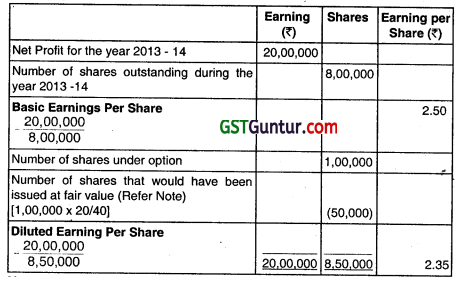
Note:
The earnings have not been increased as the total number of shares has been increased only by the number of shares (50,000) deemed for the purpose of the computation to have been issued for no consideration.
Question 101.
Answer the following:
What do you mean by Weighted average number of equity shares outstanding during the period and why Is it required to be calculated? Compute weighted average number of equity shares in the following case:
| No. of shares | ||
| 1st April, 2014 | Balance of Equity Shares | 5,00,000 |
| 30th June, 2014 | Equity Shares issued for cash | 1,00,000 |
| 15th January, 2015 | Equity Shares bought back | 50,000 |
| 31st March, 2015 | Balance of Equity Shares | 5,50,000 |
(Nov 2015, 4 marks)
Answer
Weighted average number of equity shares outstanding at the end of the year is the shares as adjusted by the number of equity shares bought back or issued during the period as multiplied by the time weighting factor. Time weighting factor is the number of days for which the specific shares are outstanding as a proportion of the total number of days in the periods a reasonable approximation of the weighted average is adequate in many circumstances.
Calculation weighted average no. of shares:
= \(\left(5,00,000 \times \frac{3}{12}\right)+\left(6,00,000 \times \frac{6.5}{12}\right)+\left(5,50,000 \times \frac{2.5}{12}\right)\)
= 1,25,000 + 3,25,000 +1,14,000
= weighted average No. of shares = 5,64,583
Question 102.
Answer the following question:
“While calculating diluted EPS, effect is given to all dilutive potential equity shares that were outstanding during the period. Explain this statement in the light of relevant AS.
Also calculate the diluted EPS from the following information:
Net Profit for the current year (After Tax) ₹ 1,00,00.000
No. of Equity shares outstanding 10,00,000
No. of 10% Fully Convertible Debentures of ₹ 100 each 1.00,000 (Each Debentures is compulsorily & fully convertible into ₹ 10 equity shares)
Debenture interest expense for the current year ₹ 5,00,000
Assume applicable Income Tax rate @ 30% (Nov 2016,5 marks)
Answer:
According to AS 20 ‘Earnings per Share’, the net profit or loss for the period attributable to equity shareholders and the weighted average number of shares outstanding during the period should be adjusted for the effects of all dilutive potential equity shares for calculation of diluted earnings per share. Hence, In calculating diluted earnings per share, effect Is given to all dilutive potential equity shares that were outstanding during the period.”
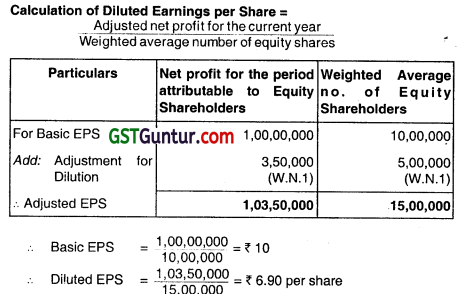
Working Note:
1. Tax-adjusted interest on 10% Convertible Debentures
= Interest × (100% – Tax Rate)
= 5,00,000 × (100% – 30%)
= 3,50,000
2. 1,00,000 × 10 × \(\frac{6}{12} \) = 5,00,000 Assumption:
Annual Interest on Debentures
= 10% × ₹ 100 × 1,00,000 Debentures
= ₹ 10,00,000
But interest expense for the current year is given as ₹ 5,00,000
Hence: It can be implied that debentures are issued during the year. Period = 6 months (By comparing Annual Interest Rate @ 10% on ₹ 10,00,000 with given interest expense ol ₹ 5,00,000)
![]()
Question 103.
As at 1st April. 2016 a company had 6,00000 equity shares of ₹ 10 each (₹ 5 paid up by all shareholders). On 1st September 2016 the remaining ₹ 5 was called up and paid by all shareholders except one shareholder having 60,000 equity shares. The net profit for the year ended 31st March, 2017 was ₹ 21,96,000 alter considering dividend on preference shares and dividend distribution tax on such dividend totaling to ₹ 3,40.000. Compute Basic EPS for the year ended 31st March, 2017 as per Accounting Standard 20 “Earnings Per Share”. (May 2018, 5 marks)
Answer:
Basic Earnings Per Share (EPS)
= \(\frac{\text { Net Profit attributable to equity shareholders }}{\text { Weighted average number of equity shares outstanding during the year }} \)
= \(\frac{₹ 21,96,000}{4,57,500 \text { shares (as per Working note) }}\)
= ₹ 4.80 per share
Working Note:
Calculation of weighted average number of equity shares. As per Para 19 of AS 20 Earnings Per Share’, partly paid equity shares are treated as a fraction of equity share to the extend that they were entitled to participate in dividend relative to a fully paid equity share during the reporting period. Assuming that the partly paid shares are entitled to participate In the dividend to the extend of amount paid, weighted average number of shares Will be calculated as follows:

Question 104.
Answer the following question:
From the following information given by Sampark Ltd., Calculate Basis EPS and Diluted EPS as per AS 20:
| ₹ | |
| Net Profit for the current year | 2,50,00,000 |
| No. of Equity Shares Outstanding | 50,00,000 |
| No. of 12% convertible debentures of ₹ 100 each | 50,000 |
| Each debenture is convertible into 8 Equity Shares Interest expense for the current year | 6,00,000 |
| Tax saving relating to interest expense (30%) | 1,80,000 |
(Nov 2018, 5 marks)
Answer:
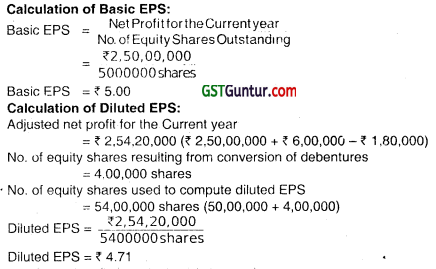
Question 105
Following information is supplied by K Ltd
Number of shares outstanding prior to right issue – 2.50,000 shares.
Right issue – two new share for each 5 outstanding shares (i.e. 1.00,000 new shares)
Right issue price – ₹ 98
Last date ol exercising rights – 30-06-2018.
Fair value of one equity share immediately prior to exercise of right on 30-06-2018 is ₹ 102.
Net Profit to equity shareholders:
2017-2018 – ₹ 50,00,000
2018-2019 – ₹ 75,00.000
You are required to calculate the basic earnings per share as per AS-20 Earning per Share. (Nov 2019, 5 marks)
Answer:
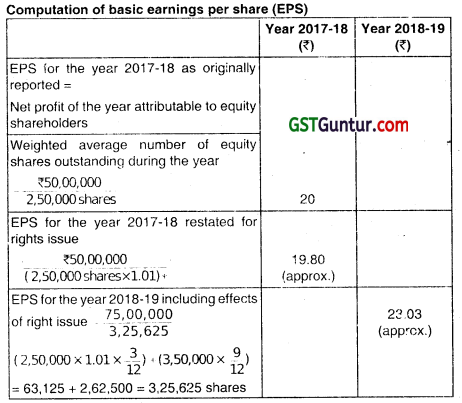
Working Notes:
1. Computation of theoretical ex-rights fair value per share:

= \(\frac{(₹ 102 \times 2,50,000 \text { shares) }+(₹ 98 \times 1,00,000 \text { shares) }}{2,50,000 \text { shares }+1,00,000 \text { shares }}\) = ₹ 100.86
2. Computation of adjustment factor:
![]()
= \(\frac{₹ 102}{₹ 100.86}\) = 1.01 (approx)
Note:
The number of equity shares to be used in calculating basic earnings per share for periods prior to the rights issue is the number of equity shares outstanding prior to the issue, multiplied by the adjustment factor, (as calculated in W.N.2).
Question 106.
XYZ Ltd. is engaged in manufacturing Industrial Packaging Equipment. As per the terms of an agreement entered into with its Debentur holders, the Company is required to appropriate adequate portion of Its Profiles to a Specific Reserve over the period of maturity of the Debentures such that at the redemption date, the Reserve constitutes at least half the value of
such Debentures. As such, appropriations are not available for distribution to the Equity Shareholders. Kashyapa Ltd. has excluded this from the Numerator, in the Computation of Basic EPS. Is this treatment correct?
Answer:
Provision:
As per Para 11 of AS -20. Earning per share “For the purpose of calculating Basic earnings Per Share, the Net Profit or Loss for the period attributable to Equity Shareholders should be the Net Profit or Loss for the period after deducting Preference Dividends and any attributable Tax thereto for the period.
Analysis: With an emphasis on the phrase ‘attributable to Equity Shareholders. it may be construed that amounts appropriated to Mandatory Reserves as described in this case, though not available for distribution as dividends, are still attributable to Equity Shareholders.
Conclusion: So, the appropriation made to a Mandatory Reserve created for the redemption of Debentures would be included in the Net Profit attributable to Equity Shareholders for the computation of Basic EPS. The treatment given by the Company is not correct.
Question 107.
From the following information, calculate Earnings Per Share (EPS), (₹ in Crores)
| Profit before VRS Payment but after depreciation | 75.00 | Provision for Taxation | 10.00 |
| Depreciation | 10.00 | Fringe Benefit Tax | 5.00 |
| VRS payments | 32.10 | Paid Up Share Capital (Shares of ₹ 10 each fully paid) | 93.00 |
Answer:
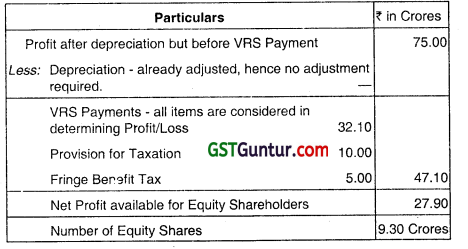

Question 108.
XYZ Ltd. has the following different classes of Equity Shares of ₹ 10 each, outstanding as at 31st March, having disproportionate rights with respect to voting and dividends:
| Number of Shares | Rights as to Share in Net Profit to the extent of Capital |
| 1,00,000 “A” Class Equity Shares | Proportion ate to Capital |
| 30,000 “B” Class Equity Shares | In the proportion of 3:2 with respect to “A” Class Shares |
| 30,000 “C” Class Equity Shares | In the proportion of 5:2 with respect to “A” Class Shares . |
| 40,000 “D” Class Equity Shares | In the proportion of 3:1 with respect to “A” Class Shares |
Profit for the year ended 31st March was ₹ 8,00000. The Company believes that Net Profit is to be allocated to the Shares in the ratio or 2:3:5:6 as derived from their rights to Share Net Profit. The Company has calculated the Basic EPS in the following manner. You are required to confirm whether this calculation is correct.
| Class | Apportionment of Net Profit | No. of Shares | Basic EPS |
| Class A | ₹ 8,00,000 x 2/16 = ₹ 1,00,000 | 1,00,000 | ₹ 1.00 |
| Class B | ₹ 8,00,000 x 3/16 = ₹ 1,50,000 | 30,000 | ₹ 5.00 |
| Class C | ₹ 8,00,000 x 5116 = ₹ 2,50,000 | 30,000 | ₹ 8.33 |
| Class D | ₹ 8,00,000 x 6/16 = ₹ 3,00,000 | 40,000 | ₹ 7.50 |
Answer:
As per Para 14, “If an Enterprise has more than one class of Equity Shares, Net Profit or Loss for the period is apportioned over the different classes of Shares in accordance with their dividend rights”. In the instant case, Net Prolit should first be apportioned to various classes of Equity Shares in accordance with their Dividend Rights in the following manner:

Conclusion: The Company’s EPS computation is not correct. The amounts presented above should be considered.
![]()
Question 109.
From the information given below, calculate the Diluted EPS of XYZ Ltd.:
Profit available for appropriation = ₹ 3750 Crores.
Equity Shares (of ₹ 10 each fully paid) outstanding as at beginning of year = ₹ 250 Crores.
No. of Loan Bonds convertible into loo Equity Shares of ₹ 10 each for each Loan Bond = 5.25 Lakhs.
No. of Equity Shares likely to arise on conversion of Series III Debentures = 3.90 Lakhs.
Interest on Loan Bonds and Senes III Debentures = ₹ 50 Crores, Tax Rate = 40%.
Potential Equity Shares on account of Stock Options = 1.15 Crores.
Answer:

Note:
Tax Adjusted Interest on Convertible Debentures
= Interest x (100%-Tax Rate)
= ₹ 50 Crores x (100%-40%) = ₹ 30 Crores.
Question 110.
Calculate Basic arid Diluted EPS of Marthanda Ltd. if:
Equity Shares (₹ 10 each) as at the beginning of the financial year – 50,00,000 Shares,
Net Profit after Tax for the year – 2,00,00,000,
Issue of Shares for Cash on 1 July – 10,00,000 Shares ( ₹ 10 each)
Issue of Bonus Shares on 1st October = 1:5 as at the beginning of year, ie. 10,00,000 Shares.
Convertible Debentures outstand4ng at beginning of the year = 10%
Debentures for ₹ 1,00,00,000.
Company’s Tax Rate is 40%.
Answer:
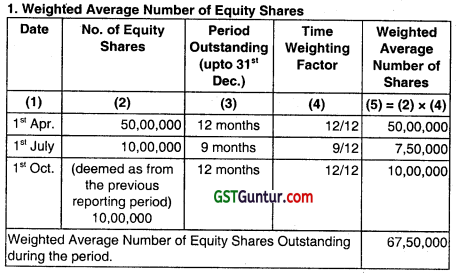
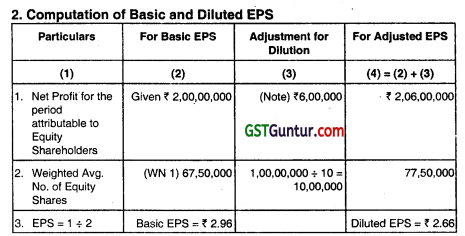
Note: Tax Adjusted Interest on Convertible Debentures = Interest X (100% – Tax Rate) = ( 1,00,00,000 x 10%) x (100% – 40%) = ₹ 6,00,000.
Question 111.
The following information is available for TON Ltd. for the accounting year 2015-16 and 201 6-17:
| Net profit for | ₹ | |
| Year | 2015-16 | 35,00,000 |
| Year | 2016-17 | 45,00,000 |
No of shares outstanding prior to right issue 15,00,000 shares.
Right issue: One new share for each 3 shares outstanding i.e. 5,00.000 shares.
: Right issue price ₹ 25
: Last date to exercise rights 31st July, 2016
Fair value of one equity share immediately prior to exercise of rights on 31 .07.2016 is ₹ 35.
You are required to compute:
(i) Basic earnings per share for the year 2015-16.
(ii) Restated basic earnings per share for the year 201516 for right issue.
(iii) Basic earnings per share for the year 2016-17.
Answer:

Question 112.
Write short note on the following:
What are Timing differences and Permanent differences? (Nov 2008, 4 marks)
OR
Answer the following:
What are Timing Differences and Permanent Differences as per Accounting Standard – 22? Explain with example. (May 2014, 4 marks)
Answer:
1. Timing difference is the difference between the accounting income and taxable income that originated in the same period and are capable of reversal in one or more subsequent periods. Examples of timing differences are as follows:
(i) Expenditure of nature mentioned in Section 43(8), like taxes, duty, cess, fees etc. il are accrued in the P/L A/c on accrual basis; but are allowed only on actual payment for tax purpose.
(ii) Provision made in PL A/c, but the relevant liability is allowed in the year in which it actualize.
2. Permanent difference is the difference between the accounting income and taxable income that originated in the same period: but are not capable of reversal. Examples of permanent differences are as follows:
- Personal expenditure
- Contribution to National Laboratory.
- Donations, etc.
Question 113.
Answer the following:
Omega Limited is working on different projects those are likely to be completed within 3 years period. It recognises revenue from these contracts on percentage of completion method for financial statement during 2006,2007 and 2008 for ₹ 11,00,000, ₹ 16,00,000 and ₹ 21,00,000 respectively. However, for Income-tax purpose, it has adopted the completed contract method under which It has recognised revenue of 7,00,000, 18,00,000 and 23,00,000 for the years 2006, 2007 and 2008 respectively. Income-tax rate is 35%. Compute the amount of deferred tax asset/liability for the years 2006, 2007 and 2008.
(May 2009, 4 marks)
Answer:

Question 114.
What do you understand by ‘provision for taxation’? What factors are to be considered while estimating the provision for taxation? (Dec 2009, 6 marks)
Answer:
Provision for Taxation:
Provision for Income Tax to be created for current year is shown in the debit side of profit and loss account as well as under provision in liabilities side in the balance sheet. li rate of Income Tax is given it will be applied on net profit. Surcharge, it any, will be calculated on Income Tax, whde calculating income tax provision as a percentage of net profit. Some adjustment may be required. Net profit as shown by profit and loss account may be different from the taxable profit. While making the estimate of provision for taxation, due consideration should be given to the following points:
- Whether the Income tax has been computed at the rates prescribed.
- Whether profit sur- tax is payable or not.
- Whether capital gains tax is payable or not.
- Whether penalty is payable under any tax laws.
- Whether rebates are available for double taxation.
- Whether adjustment has made for the last years actual tax liability or not.
Question 115.
Write short notes on the following: ‘
Provision for taxation and advance payment of tax. (Dec 2011, 3 marks)
Answer:
Provision for Taxation:
Provision for Income Tax to be created for current year is shown in the debit side of profit and loss account as well as under provision in liabilities side in the balance sheet. If rate of Income Tax is given it will be applied on net profit. Surcharge if any, will be calculated on Income Tax, while calculating income tax provision as a percentage of net profit. Some adjustment may be required. Net profit as shown by profit and loss account may be different from the taxable profit.
Advance Tax:
Any advance tax paid by company will be shown on the assets side of the balance sheet under Short-term ‘Loans and Advances’. Alternatively, it may be shown as a deduction from provision for Income Tax. If amount of advance tax is more than the amount of tax assessed, the excess is refundable by income. Tax department. This excess will be shown in the
assets side under Short terms ‘Loans and Advances’ until refund is received.
Question 116.
Rama Ltd. has provided the following information:
Depreciation as per accounting records = ₹ 2,00,000
Depreciation as per income-tax records = ₹ 5,00,000
Unamortised preliminary expenses as per tax record = ₹ 30,000
There is adequate evidence of future profit sutficiency. How much deferred Tax asseVliability should be recognized as transition adjustment? Tax rate 50%. (2011 – May 5 marks)
Answer:
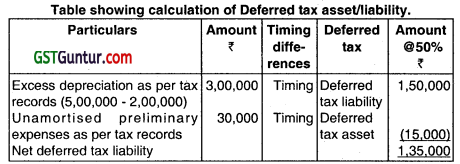
Question 117.
Goodwill Limited is a full tax free enterprise for the 1st 12 years of its existence and is in third year of operations. Depreciation timing difference resulting in a deferred tax liability In 1st, 2nd and 3rd year is ₹ 200 lakhs, ₹ 300 lakhs and ₹ 400 lakhs respectively. From the 4th year onwards, it is expected that the timing difference would reverse each year by ₹ 10 lakhs. Assuming tax rate @ 35%, find out the deferred tax liability at the end of 3rd year and any charge to the Profit and Loss Account. (Nov 2012, 5 marks)
Answer:
According to an explanation to AS 22, “Accounting for Taxes on Income”, in the case of tax free enterprises, no deterred tax liability is recognized, in respect of timing differences that originate and reverse in the tax holiday period. Deterred tax liability or asset is created in respect of timing differences that originate in a tax holiday period but are expected to reverse after the tax holiday period. For this purpose, adjustments are done in accordance with the FIFO method.
Accordingly, depreciation timing difference of ₹ 90 lakhs (₹ 10 lakhs × 9 years) will reverse in the tax holiday period i.e. from 4th year to 12th year. Therefore, no deferred liability on ₹ 90 lakhs out of ₹ 200 lakhs, will be created. In the 1st year, deferred tax liability of 38.5 lakhs will be create @ 35% on ₹ 110 lakhs ( ₹ 200 lakhs – ₹ 90 lakhs) only.
However, the entire depreciation timing difference of 2nd and 3rd year i.e. ₹ 300 Lakhs and ₹ 400 lakhs will reverse only after the tax holiday period. So, deferred tax liability will be created in the 2’ year for ₹ 105 lakhs (₹ 300 x 35%) and in the 3rd year for 140 lakhs ( 400 x 35%).
Therefore, total deferred tax liability in the Balance Sheet at the end of 3 year will be ₹ (38.5 + 105 + 140) lakhs = ₹ 283.5 lakhs and charge to Profit and Loss account in the 3rd year will be 140 lakhs (₹ 400 x 35%).
Question 118.
Rohit Ltd. has provided the following information:
| Particulars | ₹ |
| Depreciation as per accounting record | 2,50,000 |
| Depreciation as per tax records | 5,50,000 |
| Unamortized preliminary expenses as per tax record | 40,000 |
There is adequate evidence of future profit sufficiency. How much deferred tax asset/liabitity should be recognised as a transition adjustment when the tax rate is 50%? (May 2018, 5 marks)
Answer:
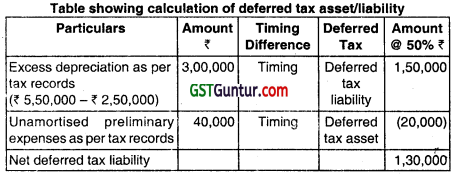
Net deferred tax liability amounting ₹ 1,30,000 should be recognized as transition adjustment.
![]()
Question 119.
Answer the following:
From the following details of Aditya Limited for accounting year ended on 31st March, 2020:
| Particulars | ₹ |
| Accounting profit | 15,00,000 |
| Book profit as per MAT | 7,50,000 |
| Profit as per Income tax Act | 2,50,000 |
| Tax Rate | 20% |
| MAT Rate | 7.5% |
Calculate the deferred tax asset/liability as per AS 22 and amount of tax to be debited to the profit and loss account for the year. (Nov 2020, 5 marks)
Question 120.
The following particulars are stated ¡n the Balance Sheet of HS Ltd. as on 31 -3-201 9:
| Particulars | (₹ In lakhs) |
| Deferred Tax Liability (Cr,) | 60.00 |
| Deferred Tax Assets (Dr.) | 30.00 |
The following transactions were reported during the year 2019-20: (₹ in lakhs)
Depreciation as per accounting records 160.00
Depreciation as per income tax records 140.00
Items disallowed for tax purposes in 2018-19 but allowed in 2019-20 20.00
Donation to Private Trust 20.00
Tax rate 30%
There were no additions to fixed assets during the year. You are required to show the impact of various items on Deferred Tax Assets and Deferred Tax Liability as on 31-3-2020 as per AS-22. (Jan 2021, 5 marks)
Question 121.
The Trial Balance of Q Ltd. as at 31.3.2018 shows the following items:

The following further information are given:
1. Advance Payment of Income Tax include ₹ 1,40,000 for 2016-17.
2. Actual Tax Liability for 2016-17 came to ₹ 1,52,000 and no effect for the same has so far been given in accounts.
3. Provision for Income Tax has to be made for 2013-14 for ₹ 1,60.000.
Prepare: (1) Provision for Income Tax Account. (2) Advance Payment of Income Tax Account, and (3) Liabilities for Taxation Account. Also show, how the relevant items will appear in the Profit and Loss Account and Balance Sheet of the Company.
Answer:
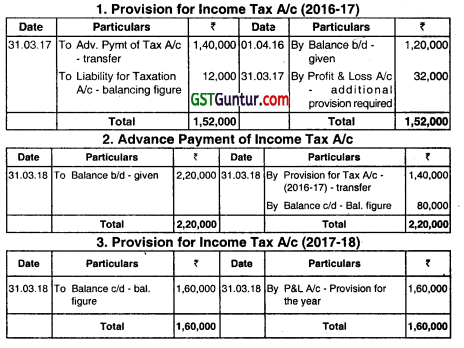
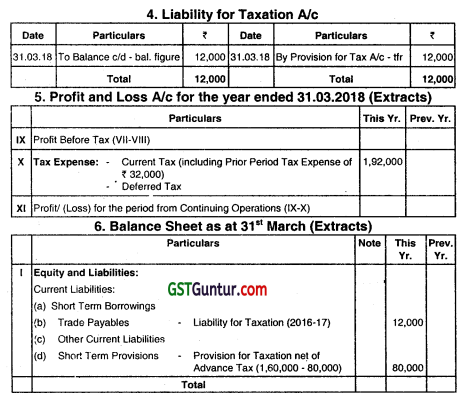
Question 122.
Give four examples of activities that do not necessarily satisfy criterion (a) of paragraph 3 of AS-24, but that might do so in combination with other circumstances. (Nov 2009, 4 marks)
Answer:
Para 3 of AS-24 “Discontinuing Operations” explains the criteria for determination of discontinuing operation. According to Paragaph 9 of AS-24, examples of activities that do not necessarily satisfy criterion (a) of paragraph 3, but that might do so in combination with other circumstances, include
- Closing of a facility to achieve productivity improvement or any other cost saving.
- Gradual/Evolutionary phasing out any product line or service or class.
- Discontinuing several products, within an ongoing line of business.
- Changing of location of production or marketing activities for a particular business line.
Question 123.
Qu Ltd. Is in the business of manufacture of Passenger cars and commercial vehicles. The company is working on a strategic plan to shift from the Passenger car segment over the coming 5 years, However no specific plans have been drawn up for sale of neither the division nor its assets. As part of its plan it Will reduce the production of passerger cars by 20% annually. It also plans to commence another new factory for the manufacture of commercial vehicles and transfer surplus employees in a phased manner.
(i) You are required to comment it mere gradual phasing out in itself can be considered as.a Discontinuing Operation within the meaning of AS-24.
(ii) If the company passes a resolution to sell some of the assets in the passenger car division and also to transfer few other assets of the passenger car division to the new factory, does this trigger the application of AS-24?
(iii) Would your answer to the above be different If the company resolves to sell the assets of the Passenger Car Division In a phased but time bound manner? (Nov 2013, 4 marks)
Answer:
Mere gradual phasing Is not considered as discontinuing operation as defined under para 3 of AS 24, Discontinuing Operation’. Examples of activities that do not necessarily satisfy intention of the definition, but that might do so in combination with other circumstances, include:
(i) Gradual or evolutionary phasing out of a product line or class of service.
(ii) Shifting of some production or reallotting activities for a particular line of business from one location to another and
(iii) Closing of a facility to achieve productivity improvements or other cost savings.
A Reportbe business segment or geographical segment as defined in AS-17, would normally satisfy criteria (b) of the definition.
In view of the above the answers are:
(i) No. The companies strategic plan has no final approval from the board through a resolution and no specific time bound activities like shifting of Assets and employees and above all the new segement commercial vehicle production line and factory has started.
(ii) No. The resolution is salient about stoppage of the Car segment in definite time period. Though, some assets sales and transfer proposal was passed through a resolution to the new factory, closure road map and new segment starting road map is missing. Hence, AS-24 will not be applicable.
(iii) Yes. Phased and time bound programme resolved in the board clearly indicates the closure of the passenger car segment in a definite time frame and clear road map. Hence, this action will attract AS-24 compliance.
Question 124.
Answer the following:
What are the initial disclosure requirements of AS 24 for discontinuing operations? (Nov 2018, 5 marks)
Answer:
Initial Disclosure requirement of AS 24 for discontinuing operation:
An enterprise should include the following information relating to a discontinuing operation in its financial statements beginning with the financial statements for the period in which the initial disclosure event occurs:
- A description of the discontinuing operation(s).
- The business or geographical segment(s) in which it is reported as per AS 17.
- The date and nature of the initial disclosure event.
- The date or period in which the discontinuance is expected to be completed if known or determinable
- The carrying amounts, as of the balance sheet date, of the total assets to be disposed of and the total liabilities to be settled.
- The amounts of revenue and expenses in respect of the ordinary activities attributable to the discounting operation during the current financial reporting period.
- The amount of pretax profit or loss from ordinary activities attributable to the discontinuing operation dunng the current financial reporting period, and the income tax expense related thereto.
- The amounts of net cash flows attributable to the operating, investing and Financing activities of the discontinuing operation during the current financial reporting period.
Question 125.
Answer the following:
M Ltd. launched a project for producing product A in Nov. 2008. The company incurred ₹ 30 lakhs towards Research and Development expenses upto 31st March 2010. Due to un favourable market conditions the management feels that it is not possible to manufacture and sold the product in the market for next so many years. the management hence wants to defer the expenditure write off to future years. Advise the company as per the applicable Accounting Standard. (Nov 2010, 4 marks)
Answer:
Provision:
As per AS – 26, expenditure on research should be recognised as an expense when it is incurred. An intangible asset arising from development (or from the development phase of an internal project) should be rrcognized if and only if, an enterprise can demonstrate all of the condit ‘ specified ¡n para 44 of the standard. An intangible asset (arising from development) should be derecognised when no future economic benefits are expect from ts use according to
provisions of AS-26.
Analysis and Conclusion:
The management cannot deter the expenditure write-off to future years and the company is required to expense the entire amount of 30 lakhs in the Profit and Loss account of the year ended 31st March, 2010.
![]()
Question 126.
Answer the following:
(a) A company had deferred research and development cost of ₹ 450 Lakhs. Sales expected in the subsequent years are as under:
| Years | Sales (₹ In Lakhs) |
| 1 | 1200 |
| 2 | 900 |
| 3 | 600 |
| 4 | 300 |
You are asked to suggest how should research and development cost be charged to Profit and Loss Account assuming entire cost of ₹ 450 Lakhs is development cost. If at the end of 3rd year, it is felt that no further benefit will accrue in the 4th year. how the unamortized expenditure would be dealt with the accounts of the Company? (May 2012, 5 marks)
Answer:
(i) Research and development cost based on sales (assumed that entire cost of 450 lakhs is development cost) Is allocated as follows:
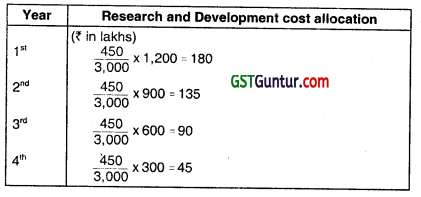
(ii) If at the end of the 3’d year, the conditions do not justify that further benefit will accrue in the 4th year, then the company has to charge the unamortised amount i.e. remaining ₹ 135 lakhs [450 – (180 + 135)] as revenue expense in 3rd year.
Question 127.
Answer the following:
An enterprise acquired patent right for ₹ 400 lakhs. The product lite cycle has been estimated to be 5 years and the amortization was decided in the ratio of estimated future cash flows which are as under:
| Year | Estimated Future Cash Flows (₹ in lakhs) |
| 1 | 200 |
| 2 | 200 |
| 3 | 200 |
| 4 | 100 |
| 5 | 100 |
After 3 year, it was ascertained that the patent would have an estimated balance future lite of 3 years and the estimated cash flow after 5th year is expected to be 50 lakhs each year. Determine the amortization under Accounting Standard 26. (May 2013, 5 marks)
Answer:
Amortization of cost of patent as per AS-28

1. In the first three years, the patent cost will be amortised In the ratio of estimated future cash flows i.e. (200: 200: 200:100: 100).
2. The unamortised portion ot the patent after third year will be ₹ 100 (400-300) which will he amortised in the ratio of revised estimated future cash flows (100:100:50) in the tourth, filth and sixth year.
Question 128.
Answer the following:
Plymouth Ltd. is engaged in research on a new process design for its product. It had incurred 10 lakhs on research during first 5 months of the financial year 2012-13. The development of the process began on 1st September. 2012 and iipto 31st March, 2013, a sum of 8 lakhs was incurred as Development Phase Expenditure, which meets assets recognition criteria. From 1st April, 2013. the Company has implemented the new process design and it is likely that this will result In after tax saving of 2 lakhs per annum for next five years. The cost of capital is 10%. The present value of annulity factor of 1 for 5 years 10% is 3.7908. Decide the treatment of Research and Development Cost of the project as per AS-26. (Nov 2013, 4 marks)
Answer:
Research Expenditure: According to AS – 26 ‘Intangible Assets’, the expenditure on research of new process design for its product ₹ 10 lakhs should be charged to “Profit and Loss Account in the year in which it is incurred. It is presumed that the entire expenditure is incurred In the financial year 2012-13. Hence, it should be written off as an expense in that year itself.
Cost of internally generated Intangible asset: it Is given that development phase expenditure amounting ₹ 8 lakhs incurred upto 31st March, 2013 meets asset recognition criteria. As per AS-26, for measurement of such Internally generated intangible asset, fair value can be estimated by discounting estimated future net cash flows.

The cost of an internally generated intangible asset would be lower of cost value ₹ 8 lakhs or present valuo of future net cash flows ₹ 7.582 lakhs. Hence, cost of an internally generated intangible asset will be ₹ 7.582 lakhs. The difference of ₹ 0.418 lakhs (i.e. ₹ 8 lakhs – ₹ 7.582 lakhs) will be amortized by Plymouth for the financial year 2012-13.
Amortisatlon: The company can amortise ₹ 7.582 lakhs over a period of five years by charging ₹ 1.5164 lakhs per annum from the financial year 2013-2014 onwards.
Question 130.
Answer the following:
A company is showing an intangible asset at 88 lakhs as on 01.04.2013. This asset was acquired for ₹ 120 lakhs on 01.04.2009 and the same was available for use from that date. The company has been following the policy of amortization of the intangible assets over a period of 15 years on straight-line basis. Comment on the accounting treatment of the above
with reference to the relevant Accounting Standard. (Nov 2014, 5 marks)
Answer:
According to AS-26 ‘Intangible Assets’, the depreciable amount of an intangible asset should be allocated on systematic basis over the best estimate of its. useful lite. There is a rebuttable presumption that the useful lite of an intangible asset will not exceed 10 years from the date when the asset is available for use. Company has been following the policy of amortisation of the intangible asset over a period of 15 years on straight line basis, The period of 15 years is more than the maximum period of 10 years specified as per AS-26.
According to the above, the company would be required to restate the carrying amount of intangible asset as on 01.04.2013 at ₹ 72 lakhs i.e. ₹ 120 lakhs less 48 lakhs
\(\left(\frac{₹ 120 \text { Lakhs }}{10 \text { Years }} \times 4 \text { years }=48 \text { Lakhs }\right)\)
Difference of ₹ 16 Lakhs (i.e. ₹ 88 lakhs – ₹ 72 lakhs) will be adjusted against the opening baLance of revenue reserve. The carrying amount of ₹ 72 lakhs will be amortised over remaining 6 years by amortising ₹ 12 lakhs per year.
Question 131.
Answer the following:
M/s. Mahesh Ltd. is developing a new production process. Dunrig the Financial Year ended 31st March, 2013. the total expenditure incurred on the process was ₹ 60 Lakhs. The production process met the criteria for recognition as an intangible asset on 1st December, 2012. Expenditure incurred till this date was ₹ 32 Lakhs. Further expenditure incurred on the process for the Financial Year ending 31st March, 2014 was ₹ 90 Lakhs. As on 31.03.2014, the recoverable amount of know-how embodied in the process is estimated to be ₹ 82 Lakhs. This includes estimates of future cash outflows and inflows.
You are required to work out:
(i) What is the expenditure to be charged to Profit 8 Loss Account for the year ended 31st March, 2013?
(ii) What is the carrying amount of the intangible asset as on 31st March, 2013?
(iii) What is the expenditure to be charged to Profit & Loss Account for the year ended 31 March, 2014?
(iv) What is the carrying amount of the intangible asset as on 31st March. 2014? (May 2015, 5 marks)
Answer;
As per AS-26, the amount charged and recognised are as follows:
(i) The expenditure to be charged to Profit & Loss A/c for year ended 31st March, 2013:
₹ 32 lakhs will be recognised as an Expense because the recognition criteria were not met until 1st December, 2012. This expenditure will not form part of the cost of the production process recognised in the Balance Sheet.
(ii) The carrying amount of the asset as on 31st March, 2013:
The production it is incurred, unless it forms part of the cost of an Intangible Asset.
Analysis:
In the given case, advertisement expenditure of 3 crore had been taken for the marketing of a new product which may provide future econnrnic benefits to an enterprise by having a turnover of ₹ 37.5 crores. Hero, no intangible asset or other asset is acquired or created that can be recognised.
Conclusion:
Therefore, the accounting treatment by the company of debitng the entire advertising expenditure of ₹ 3 crore to the Profit and Loss Account of the year is correct.
Question 132.
Answer the following question:
Fast Ltd. acquired a patent at a cost of ₹ 4,00,000 for a period of five years and its product life cycle is also five years. The company capitalized the cost and started amortizing the as! at ₹ 5,00,000 per annum. After two years, it was found that the product life -cycle may continue for another 5 years from then. The net cash flows from the product during these 5
years are expected to he ₹ 10,00,000, ₹ 23,00,000, ₹ 22,00,000, ₹ 20.00,000 and ₹ 17,00000. Find out the amortization cost of the patent for each of the years. (May 2017, 5 marks)
Answer:
As per AS-26, “Intangible Assets’, Fast Ltd. amortized ₹ 5,00,000 per annum for the first two years ie., ₹ 10,00,000. The remaining carrying cost can be amortized during next 5 years on the basis of net cash flows arising from the sale of the product. The amortization may be found as follow:
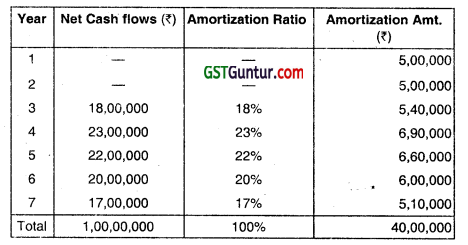
It may be seen from above that from third year onwards, the balance of carrying amount i.e., ₹ 30,00,000 has been amortized In the ratio of net cash flows arising from the product of Fast Ltd.
Note: The answer has been given on the basis that the patents renewable and Fast Ltd. got it renewed after expiry of five years.
Question 133.
A company acquired a patent at a cost of 160 lakhs for a period of 5 years and the product life cycle is also 5 years. The company capitalized the cost and started amortising the asset at ₹ 16 lakhs per year based on the economic benefits derived from the product manufactured under the patent. After 2 years It was found that the product life cycle may continue for another 5 years from then (the patent is renewable and the company can get it renewed after 5 years). The net cash flows from the product during these 5 years were expected to be ₹ 50 lakhs, ₹ 30 lakhs, ₹ 60 lakhs, ₹ 70 lakhs and ₹ 40 lakhs. Find out the amortization cost of the patent for each of the years. (May 2018, 5 marks)
Answer:
The company amortised ₹ 16,00,000 per annum for the first two years i.e. ₹ 32,00.000. The remaining carrying cost can be amortised during next 5 years on the basis of net cashflows arising from the sale of the product. The amortisation may be found as follows:
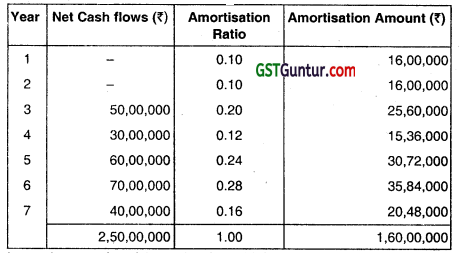
It may be seen from above that from third year onwards, the balance of carrying amount i.e. ₹ 1,28,00,000 has been amortised In the ratio of net cash flows arising from the product of the company.
Question 134.
As per provision of AS-26, how would you deal to the following situations:
1. ₹ 23,00,000 paid by a manufacturing company to the legal advisor defending the patent of a product is treated as a capital expenditure.
2. During the year 2018-19, a company spent ₹ 7,00,000 for publicity and research expenses on one of its new consumer product which was marketed in the same accounting year but proved to be a failure.
3. A company spent ₹ 25,00,000 in the past three years to develop a product, these expenses were charged to profit and loss account since they did not meet AS-26 criteria for capitalization. In the current year approval of the concerned authority has been received. The
company wishes to capitalize ₹ 25,00,000 by disclosing it as a prior period item.
4. A company with a turnover of ₹ 200 crores and an annual advertising budget of ₹ 50,00,000 had taken up for the marketing of a new product by a company. It was estimated that the company would have a turnover of ₹ 20 crore from the new product. The company had debited to its Profit & Loss Account the total expenditure of ₹ 50,00,000 incurred on extensive special initial advertisement campaign for the new product. (Nov 2019, 5 marks)
Answer:
As per AS 26 ‘Intangible Assets’, expenditure on an intangible item should be recognised as an expense when it is incurred unless:
(a) It forms part of the cost of an intangible asset that meets the recognition criteria.
(b) The item Is acquired in an amalgamation in the nature of purchase and cannot be recognised as an intangible asset. It forms part of the amount attributed to goodwill (Capital reserve) at the date of acquisition. In some cases, expenditure is incurred to provide futt’e economic benefits to an enterprise, but no intangible asset or other asset is acquired or created that can be recognised. In these cases, the expenditure is recognised as an expense when it is incurred.
1. Here, no intangible asset or other asset is created and does not meet recognition criteria fulfilled by paying ₹ 2300,000 to legal advisor for defending the patent. So that ₹ 23,00.000 is to be recognised as expenditure and charged to piotit and loss account, hence, ₹ 23,00,000 should not be capitalised.
2. In the given case, the company spent ₹ 7,00,000 for publicity and research of a new product which was marketed but proved to be a failure. It is clear that in future there will be no related further revenue! benefit because of the failure of the product. Thus, according to AS-26 Intangible Assets’, the company should charge total amount of ₹ 7,00,000 as an expense in the Profit and Loss Account.
3. In this case, the company spent ₹ 25,00,000 in the past three years to develop a product, these expenses were charged to profit and loss account since they did not meet AS-26 criteria for capitalization. In the current year after receiving approval from concerned authority, the company wishes to capitalize ₹ 25,00,000 by disclosing it as a prior period item. According to AS 26, once the amount charged to profit and loss account, it cannot be capitalized. So here, the company cannot capitalize ₹ 25.00,000 as a prior period item.
4. According to AS 26 ‘Intangible Assets’, “expenditure on an intangible item should be recognised as an expense when it is incurred unless It forms part of the cost of art Intangible asset. As 26 mentions that expenditure on advertising and promotional activities should be recognised as an expense when incurred.
In the given case, advertisement expenditure of ₹ 50,00,000 had been taken up.f or the marketing of a new product which may provide future economic benefits to an enterprise by having a turnover of ₹ 20 crore. Here, no intangible asset or other asset is acquired or created that can be recognised. Therefore, the accounting treatment by the company of debiting the entire advertising expenditure of ₹ 50,00,000 to the Profit and Loss Account of the year is correct.
Question 135.
Answer the following:
Swift Limited acquired patent rights to manufacture Solar Roof Top Panels at a cost of ₹ 600 lacs. The product life cycle has been estimated to be 5 years and the amortization was decided in the ratio of future cash flows which are estimated as under:
| Year | 1 | 2 | 3 | 4 | 5 |
| Cash Flows (₹ In lacs) | 300 | 300 | 300 | 150 | 150 |
After 3rd year, it was estimated that the patents would have an estimated balance future life of 3 years and Swift Ltd expected the estimated cash flow after 5th year to be ₹ 75 Lacs. Determine the amortization cost of the patent for each of the above years as per Accounting Standard 26. (Nov 2020, 5 marks)
Question 136.
Answer the following:
M/s. Pasa Ltd. is developing a new production process. During the financial year ended 31 March, 2019, the total expenditure incurred on the process was 80 lakhs. The production process met the criteria for recognition as an intangible asset on 1st November, 2018. Expenditure incurred till this date was ₹ 42 lakhs. Further expenditure incurred on the process for the financial year ending 31st March, 2020 was ₹ 90 lakhs. As on 31,03.2020. the recoverable amount of know how embodied in the process is estimated to be ₹ 82 lakhs. This includes estimates of future cash outflows and inflows.
You are required to work out:
(1) What is the expenditure to be charged to Profit and Loss Account for the year ended 31st March, 2019?
(2) What is the carrying amount of the intangible asset as on 31st March, 2019?
(3) What is the expenditure to be charged to Profit and Loss Account for the year ended 31st March, 2020? What is the carrying amount 01 the intangible asset as on 31st March, 2020? (Nov 2020, 5 marks)
Question 137.
A Company acquired for its internal use a software on 01.03.2020 from U.K. for £ 1.50,000. The exchange rate on the date was as ₹ 100 per £. The seller allowed trade discount @ 2.5%. The other expenditures were:
(i) Import Duty 10%
(ii) Additional Import Duty %
(iii) Entry Tax 2% (Recoverable later from tax department)
(iv) Installation expenses ₹ 1,50,000
(v) Professional fees for clearance from customs ₹ 50,000.
Compute the cost of software to be Capitalised as per relevant AS. (Jan 2021, 5 marks)
Question 138.
Desire Ltd acquired a patent at a cost of ₹ 1,00,00,000 for a period of 5 years and the product life-cycle is also 5 years. The company capitalized the cost and started amortizing the asset on SLM. After two years it was found that the product life -cycle may continue for another 5 years from then The net cash flows from the product during these 5 years were expected to be ₹ 45.00,000, ₹ 42,00,000. ₹ 40,00,000, ₹ 38,00,000 and ₹ 35,00000. Patent is renewable and company changed amortization method from 3’ year (i.e. from SLM to ratio of expected new cash flows). You are required to compute the amortization cost of the patent for each of the years (1st year to 7th year).
Answer:
Desire Limited amortised ₹ 20,00.000 per annum for the first two years i.e. ₹ 40,00,000. The remaining carrying cost can be amortized during next 5 years on the basis of net cash flows arising from the sale of the product. The amortisation may be found as follows:
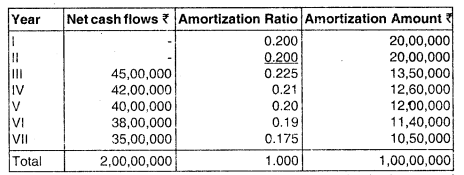
It may be seen from above that from third year onwards, th balance of carrying amount i.e., ₹ 60,00,000 has been amortized in the ratio of net cash flows arising from the product of Desire Ltd.
Question 139.
Answer the following:
An airline is required by law to overhaul its aircraft once In every five years. The Pacific Air lines which operates aircrafts does not provide any provision as required by law in its final accounts. Discuss with reference to relevant Accounting Standard 29. (May 2012, 4 marks)
Answer:
A provision should be recognised only when an enterprise has a present obligation as a result of a past event. In the given case, there is no present obligation, therefore no provision is recognised as per AS 29. The cost of overhauling aircraft is not recognized as a provision because it is a future obhgation and the incurring of the expenditure depends on the company’s decision to continue operating the aircrafts. a Even a legal requirement to overhaul does not require the company to make a provision for the cost of overhaul because there is no present obligation to overhaul the aircratts.
Further, the enterprise can avoid the future expenditure by its future action, for example by selling the aircraft. However, an obligation might arise to pay fines or penalties under the legislation after completion of five years. Assessment of probability of incurring fines and penalties depends upon the provisions of the legislation and the stringency of the enforcement regime. A provision shoyld be recognized for the best estimate of any fines and penalties if airline continues to operate air crafts for more than five years.
![]()
Question 140.
Answer the following:
A company is in a dispute involving aNegation of infringement of patents by a competitor company who is seeking damages of a huge sum of ₹ 900 lakhs. The directors are of the opinion that the claim can be successfully resisted by the company. How would you deal the same in the annual accounts of the company? (Nov 2012, 4 marks)
Answer:
Provision:
As per AS-29, (Revised) Provisions, Contingent Liabilities and Contingent Assets, a provision should be recognised when:
(a) an enterprise has a present obligation as a result of a past event;
(b) it is probable that an outflow of resources embodying economic benefits will be required to settle the obligation; and
(c) a reliable estimate can be made of the amount of the obligation. It these conditions are not met, no provision should be recognised.
Analysis and Conclusion:
In the given situation, since, the directors of the company are of the opinon that the claim can be successfully resisted by the company, therefore there will be no outflow of the resources. The company will disclose the same as contingent liability by way of the following note:
Litigation is in process against the company relating to a dispute with a competitor who alleges that the company has infringed patents and is seeking damages of ₹ 900 lakhs. However, the directors are of the opinion that the claim can be successfully resisted by the company.”
Question 141.
Answer the following:
An engineerng goods company provides after sales warranty for 2 years to its customers. Based on past experience, the company has the following policy (or maktng provision for warranties on the nvoice amount, on the remaining balance warranty period:
Less than 1 year: 2% provision
More than 1 year: 3% provision
The company has raised invoices as under:
| Invoice Date | Amount (₹) |
| 19th January, 2011 | 40,000 |
| 29th January, 2012 | 25,000 |
| 15th October, 2012 | 90,000 |
Calculate the provision to be made for warranty under Accounting Standard 29 as at 31st March, 2012 and 31 March, 2013. Also compute amount to be debited to Profit and Loss Account for the year ended 31st March. 2013. (May 2013, 5 marks)
Answer:
Provision to be made for warranty under AS 29 ‘ProvIsions, Contingent Liabilities and Contingent Assets’
As at 31st March, 2012 = ₹ 40,000 x .02 + ₹ 25,000 x .03
= ₹ 800 + ₹ 750
= ₹ 1,550
As at 31st March, 2013 = ₹ 25,000 x .02 + ₹ 90,000 x .03
= ₹ 500 + ₹ 2,700 = ₹ 3,200
Amount debited to Profit and Loss Account for year ended 31st March, 2013

Note: No provision will be computed on 31st March, 2013 in respect of sales amounting ₹ 40,000 made on 19th January, 2011 as the warranty period of 2 years has already expired.
Question 142.
Answer the following:
WZW Ltd. is in dispute involving allegation of infringement of patents by a competitor company who is seeking damages of a huge sum of ₹ 1,000 Lakhs. The director are of the opinion that the claim can be successfully resisted by the company. How would you deal the same in the Annual Accounts of the company? (Nov 2014, 5 marks)
Answer:
According to AS-29 ‘Provisions, Contingent Liabilities and Contingent Assets’, a provision should be recognised when:
(i) An enterprise has a present obligation as a result of past event;
(ii) It is probable that an outflow of resources embodying economic benefits will be required to settle the obligation; and
(iii) A reliable estimate can be made of the amount of the obligation
if such conditions are not met, no provision should be recognised. A contingent liability is disclosed, unless the possibility of an outflow of resources embodying economic benefits is remote. The possibility of an outflow of resources embodying economic benefits is remote in the given situation, since the directors of the company are of the opinion that the claim can be successfully resisted by the company. Therefore, the company shall not disclose the same as
contingent liability.
Where as the following note in this regard may be given in annual accounts:
“Litigation is in process against the company relating to a dispute with a competitor who alleges that the company has infringed patents and is seeking damages of ₹ 1,000 lachs. However, the directors are of the opinion that the claim can be successfully resisted by the company”.
Question 143.
Answer the following;
M/s. Shishir Ltd., a public Sector Company, provides consultancy and engineering services to its clients. In the year 2014-15, the Government set up a commission to decide about the pay revision. The pay will be revisod with respect from 1-1-2012 based on the re commendations of the commission. The company makes the provision of ₹ 1250 lakhs for pay revision in the financial year 2014 – 15 on the estimated basis as the report of the commission is yet to come. As per the contracts with client on cost plus job. the billing is done on the actual payment made to the employees and allocated to jobs based on hours booked by these employees on each job.
The company discloses through flotes to accounts:
“Salaries and benefits include the prevision of ₹ 1,250 Lakhs in respect of pay revision. The amount chargeable from reimbursable jobs will be billed as per the contract when the actual payment is made.
The Accountant feels that the company should also book/recognize the income by ₹ 1250 lakhs in Profit & Loss Account as per the terms of the contract. Otherwise, it will be the violation of matching concept and understatement of profit. Comment on the opinion of the Accountant with reference to relevant Accounting Standards. (May 2015, 5 marks)
Answer:
Provision:
As per AS-29, ‘Provisions, Contingent Liabilities and Contingent Assets’, where sorne or all of the expenditure required to settle a provision is expected to be reimbursed by another party, the reimbursement should be recognized when, and only when, it is virtually certain that reimbursement will be received if the enterprise settles the obligation. The reimbursement
should be treated as a separate asset. The amount recognized for the reimbursement should not exceed the amount of the provision.
Thus, potential loss to an enterprise may be reduced or avoided because a contingent liability is matched by a related counter-claim or claim against a third party. In such cases, the amount of the provision is determined after taking into account the probable recovery under the claim if no significant uncertainty as to its measurability or collectability exists.
Present Case: The provision of salary to employees of ₹ 1,250 lakhs will be ultimately collected from the client, as per the terms of the contract. There fore, the liability of ₹ 1,250 lakhs is matched by the counter claim from the client. Hence, the provision for salary of employees should be matchedb with the reimbursable asset to be claimed from the client. It appears that the whole amount of ₹ 1,250 lakhs is recoverable from client and there is no
significant uncertainty about the collection. Hence, the net charge to profit and Loss account should be nil.
The opinion of the accountant regarding recognition of income of ₹ 1.250 lakhs is not as per AS-29 and also the concept of prudence will not be followed if ₹ 1,250 lakhs is simultaneously recognized as income.₹ 1,250 lakhs is not the revenue at present but only reimbursement of claim for which an asset is created. However, the accountant Is correct to the extent as that non- recognition of ₹ 1,250 lakhs as income will result in the understatement of profit. To avoid this, in the statement of profit and loss, expense relating to provision may be presented net of he amount recognized for reimbursement.
Question 144.
Answer the following:
With reference to AS 29 Provisions, Contingent Liabilities and Contingent Assets”, define:
(i) A Provision .
(ii) A Liability
(iii) A Contingent Asset
(iv) Present Obligation (May 2016, 4 marks)
Answer:
(i) A Provision:
A Provision is a liability, which can be measured only by using a substantial degree of estimation.
(ii) A Liability:
A Liability is an obligation which the enterprise has to pay to some parties based on some contractual or any other trading arrangements within some specified or reasonable time period. So that it is considered as amount payable.
(iii) A Contingent Asset:
A Contingent Asset is a possible asset that arises from past events the existence of which wIN be conf irme only by the occurrence or non occurrence of one or more uncertain future events not wholly within the control of the enterprise.
(iv) Present Obligation:
Present Obligation is an obligation of outflow of resources that is probable and reliable. It is estimated that amount is payable in present situation.
Question 145.
M/s. XYZ Ltd. is in a dispute with a competitor company. The dispute is regarding alleged infringement of Copynghts. The competitor has filed a suit in the court of law seeking damages of ₹ 200 Lakhs. The Directors are of the view that the claim can be successfully resisted by the Company. How would the matter be dealt in the annual accounts of the Company in the light of AS-29? Explain in brief giving reasons for your answer. (Nov 2016, 4 marks)
Answer:
Provision:
As per para 14 of AS-29, ‘provisIons,’ Contingent Liabilities and Contingent Assets’ a provision should be recognised when:
(a) an enterprise has a present obligation as a result of a past event;
(b) a reliable estimate can be made of the amount of the obligation;
(c) it is probable that the outflow of resources embodying economic benefits will be required to settle the obligation. It these conditions are not met, no provision should be recognised.
Analysis & Conclusion:
In the given situation, since the directors of the company are of the opinion that the claim can be successfully resisted by the company, therefore there will be not outflow of the resources. The company will disclose the same as contingent liability by way of the following note: Litigation is in process against the company relating to a dispute with a competitor who alleges that the company has infringed patents and is seeking damages of ₹ 200 lakhs. However, the directors are of the opinion that the claim can be successfully resisted by the company”.
![]()
Question 146.
Lugal department of XYZ Limited provides that as on 31st March, 2017, there were 25 law suits pending which have not been settled till the approval of accounts by the Board of Directors. The possible outcome of suits are follows:

Outcome of each case is to he taken as a separate one Ascertain the amount of contingent loss to be reported ¡n the Financial Statement. (Nov 2017, 5 marks)
Answer:
According to AS- 29 4Provisions, contingent liabilities and contingent assets’, contingent liability should be disclosed in the financial statements it following conditions are satisfied:
(i) There is a present obligation arising out of past events but not recognized as provision.
(ii) It is not probable that an outflow of resources embodying economic benefits will be required to settle the obligation.
(iii) The possibility of an outflow of resources embodying economic benefits ¡s also remote.
(iv) The amount of the obligation cannot be measured with sufficient reliability to be recognized as provision.
In this case, the probability of winning first 7 cases is 100%. The probability of winning next twelve cases is 60% and for remaining six cases is 50%. In other word, probability of losing the cases is 40% and 50% respectively.
According to AS- 29. we make a provision if the loss is probable. As the loss does not appear to be probable and the probability or possibility of an outflow of resources embodying economic benefits is not remote rather there is reasonable possibility of loss, therefore, disclosure by way of note of contingent liability amount may be calculated as under:
Expected loss in next twelve cases
= [₹ 1,50,000 × 30% + ₹ 2,50,000 × 10%] × 12
= [45,000 + 25,000] × 12
= 70,000 × 12
= ₹ 8,40,000
Expected loss in remaining six cases
=[₹ 1,25.000 × 35% + ₹ 3,00,000 × 15%] × 6
= [43.750 + 45,000] × 6
= 88,750 × 6
= 5,32,500
Total contingent liability = 8,40,000 + 5,32,500 = ₹ 13,72,500
Expected loss in next twelve cases
= ₹ 2,50,000 × 12 cases
=₹ 30,00,000
Expected loss in remaining six cases
= ₹ 3,00,000 × 6 cases
= ₹ 18,00,000
Total = ₹ 30,00,000 + ₹ 18,00,000
= ₹ 48,00,000
Disclosure:
(a) Disclosure of contingent liability on the basis of maximum loss at ₹ 48,00,000 will be highly unrealistic since it does not recognize the probability of winning some cases and paying low damages in some cases.
(b) It will be advisable to disclose the overall expected loss of ₹ 13,72,500 as contingent liability not provided for in the accounts.
Question 147.
A Ltd. provides after sales warranty for two years to its customers. Based on past experience, the company has the following pohcy for making provision for warranties on the invoice amount on the remaining balance warranty period.
Less than 1 year: 2% provision
More than 1 year: 3% provision
The company has raised invoices as under:
| Invoice Date | Amount (₹) |
| 11th Feb, 2017 | 60,000 |
| 25th Dec, 2017 | 40,000 |
| 04th Oct, 2018 | 1,35,000 |
Calculate the provision to be made for warranty under AS-29 as at 31st March, 2018 and 31 w March, 2019. Also compute amount to be debited to P & L account for the year ended 31 March, 2019. (Nov 2019, 5 marks)
Answer:
Provision to be made for warranty under AS 29, ‘Provisions, Contingent Liabilities and Contingent Assets’:
As at 31st March, 2018 = ₹ 60,000 × 0.02 + ₹ 40,000 × 0.03
= ₹ 1,200 + ₹ 1,200
= ₹ 24,00
As at 31st March, 2019 = ₹ 40,000 × 0.02 + ₹ 1,35,000 × 0.03
=₹ 800 ÷ ₹ 4,050
= ₹ 4,850
Amount Debited to Profit and Loss Account for the year ended 31st March, 2019
| ₹ | |
| Balance of provision required as on 31.03.2019 | 4850 |
| Less: Opening Balance as on 01.04.2018 | (2,400) |
| Amount debited to profit and loss account | 2,450 |
Note: No provision will be made on 31st March, 2019 In respect of sales amounting ₹ 60,000 made on 11th February, 2017 as the warranty period of 2 years has already expired.
Question 148.
Answer the following: :
With reference to AS 29, how would you deal with the following in the Annual Accounts of the company at the Balance Sheet date:
(i) The company operates an offshore oil field where its licensing agreement requires it to remove the oil rig at the end of production and restore the seabed. Eighty-five percent of the eventual costs relate to the removal of the oil rig and restoration of damage caused by building it, and fifteen percent arise through the extraction of oil. At the balance sheet date, rig has been constructed but no oil has been extracted.
(ii) The Government introduces a number of changes to the taxation laws. As a result of these changes, the company will need to train a large proportion of its accounting and legal workforce in order to ensure continued compliances with tax law regulations. At the balance sheet date, no retraining of staff has taken place. (Nov 2020, 5 marks)
![]()
Question 149.
M/s. XYZ Ltd. is in a dispute with a competitor company. The dispute is regarding alleged infringement of Copyrights. The competitor has filed a suit in the court of law seeking damages of ₹ 200 lakhs. The Directors are of the view that the claim can be successfully resisted by the Company. How would the matter be dealt in the annual accounts of the Company in the light of AS-29? You are required to explain in brief giving reasons for your answer.
Answer:
As per AS – 29, ‘Provisions. Contingent Liabilities and Contingent Assets’, a provision should be recognized when
(a) an enterprise has a present obligation as a result of a past event:
(b) it is probable that an outi low of resources embodying economic benefits will be required to settle the obligation; and
(c) a reliable estimate can be made of the amount of the obligation.
If these conditions are not met, no provision should be recognized. In the given situation, since, the directors of the company are o the opinion that the claim can be successfully resisted by the company, therefore there will be no out flow of the resources. Hence, no provision is required The company will disclose the same as contingent liability by way of the following note:
“Litigation is in process against the company relating to a dispute with a competitor who alleges that the company has infringed copy rights and is seeking damages of ₹ 200 lakhs. However, the directors are of the opinion that the claim can be successfully resisted by the company.